Armorial of British universities
The armorial of British universities is the collection of coats of arms of universities in the United Kingdom. Modern arms of universities began appearing in England around the middle of the 15th century, with Oxford's being possibly the oldest university arms in the world, being adopted around the end of the 14th century.[1] The earliest granting of university arms was to King's College Cambridge by Henry VI in 1449.[2][3][4] Arms are granted by the College of Arms[5] and Lyon Court. It has been suggested that new universities register arms in an attempt to appear more traditional or legitimate.[6] As corporations, older university arms have historically been granted without a crest, however newer institutions use crests with mantling, including new colleges at older universities.[7][8][9] The first crest granted to a university was to Leeds in 1905 while the first British university to be granted supporters was Sussex in 1962, although both Oxford and Cambridge have used angels as supporters and Cambridge has used the 'alma mater' emblem as a crest without these components being officially granted.[10]

University and college arms often incorporate, or are simply copies of, arms of their founders or local authorities.[2][3][11] At collegiate universities, constituent colleges may bear their own arms, such as at Cambridge and Oxford.[2][3] Many older coats of arms were recorded by Arthur Charles Fox-Davies in The Book of Public Arms in 1915, which also recorded some coats of arms of constituent colleges,[12] and by John Woodward in A Treatise on Ecclesiastical Heraldry in 1894.[13] Most university mottos are not granted with the coats of arms, instead being added by custom by the institution, an exception to this being the arms of Imperial College London.[14] Those universities in Ireland that existed prior to independence from the United Kingdom were granted arms along the lines of other British universities;[15] these are listed separately below.
An open book (referencing historically the Christian bible) as symbol of 'wisdom', 'knowledge', 'learning' is common to many arms. The sun, a flaming torch or a lamp representing enlightenment features often, as does a wheatsheaf symbolising growth and an owl representing wisdom. A martlet representing strenuous effort is sometimes found. Keys in the form of crossed keys, pairs of keys or a single key held by a beast are also common to several university arms. The keys represent access to heaven and symbolically the access to greater things brought about through education.
Not all universities have a coat of arms. Many arts universities are not armigerous:
- Arts University Bournemouth
- Arts University Plymouth
- Leeds Arts University
- Norwich University of the Arts
- Ravensbourne University London
- University for the Creative Arts
Additionally, the following are also non-armigerous:
- Arden University
- Bath Spa University
- BPP University
- Leeds Beckett University
- Oxford Brookes University
- Regent's University London
- University of Bedfordshire
- University of Brighton
- University College London
- University of Cumbria
- University of Roehampton
- University of West London
The images below may be either be the coat of arms in the form of a shield (escutcheon) or the 'full heraldic achievement', as granted by the College of Arms or the Lyon Court. Some arms may be assumed arms, often taken from a founder or benefactor, particularly in the case of colleges and halls within universities.[16]
Arms of universities
Ancient Universities
| Arms | University | Full Achievement |
|---|---|---|
 |
Aberdeen, granted 26 September 1888
Escutcheon: Quarterly: 1st Azure a bough pot Or charged with three salmon fishes in fret Proper and containing as many lilies of the garden the dexter in bud the centre full blown and the sinister half blown also Proper flowered Argent issuant from the middle chief amid rays of the sun a dexter hand holding an open book likewise Proper, 2nd Argent a chief paly of six Or and Gules, 3rd Argent a chevron sable between three boars' heads erased Gules armed of the field and langued Azure, 4th Gules a tower triple-towered Argent masoned Sable windows and port of the last. The university's coat of arms incorporates those of the founders and locations of the two colleges it is derived from. In the top left quadrant are the arms of the burgh of Old Aberdeen, with the addition of a symbol of knowledge being handed down from above. Top right are those of George Keith, the fifth Earl Marischal. Bottom left are those of Bishop William Elphinstone.[17] The bottom right quarter is a simplified version of the three castles which represent the city of Aberdeen[18] (this symbol of the city also appears prominently on the arms of The Robert Gordon University). |
|
 |
Cambridge, granted 1573[19] Escutcheon: Gules on a cross Ermine between four lions passant Or a Bible lying fessways of the field clasped and garnished of the third the clasps in base. The lions represent the university's royal patronage, the ermine represents dignity, and the Bible on the cross represents both knowledge and the Christian faith. | |
 |
Edinburgh, granted 22 October 1789
Escutcheon: Argent on a saltire Azure between a thistle Proper in chief and a rock Sable in base a book expanded Or. The saltire and thistle are national symbols of Scotland (although the former's colours are reversed), while the castle is taken from the coat of arms of Edinburgh. The open book symbolizes learning.[20] | |
 |
Glasgow, granted 14 June 1900
Escutcheon: Azure the university mace in pale Or between on the dexter a tree surmounted on top by a bird Proper on the sinister an ancient handbell and in chief an open book Argent and surmounted in base of a salmon on its back holding in its mouth a signet ring also Proper. The tree, bird, bell and fish (salmon) are taken from the coat of arms of the city of Glasgow and refer to Saint Mungo. In addition there is a book representing learning and a depiction of the university mace. | |
 |
Oxford, confirmed in 1574
Escutcheon: Azure, upon a book open proper leathered gules garnished or having on the dexter side seven seals of the last the words DOMINVS ILLVMINATIO MEA all between three open crowns two and one or. In his Display of Heraldrie (1610), John Guillim interprets the arms as follows: | |
 |
St Andrews, granted 24 November 1905
Escutcheon: Parted per saltire Argent and Azure in chief a book expanded Proper leaved Gules and in base a lion rampant of the last armed and langued of the second on a chief of the fourth a crescent reversed of the first between two mascles Or. The silver and blue saltire references Scotland. The open book represents learning. The lion rampant is from the royal arms of Scotland and represents King James I (1406–1437). The crescent moon represents Peter de Luna who as Pope Benedict XIII issued the bulls of foundation in 1413. The gold diamonds on the chief are taken from the personal arms of Henry Wardlaw, Bishop of St Andrews (1404–1440).[22] |
19th Century Universities
| Arms | University | Full Achievement |
|---|---|---|
 |
Durham, granted 22 May 1843[23]
Escutcheon: Argent a Cross Pattée quadrate Gules; a Canton Azure charged with a Chevron Or between three Lions rampant of the First. The arms feature St Cuthbert's cross, referencing the link to Durham Cathedral (the shrine of St Cuthbert) and, in the canton, the arms of Bishop Hatfield of Durham, the founder of Durham College, Oxford, advancing the idea that the university is its successor institute.[24][25] St Cuthbert's Cross was used as the university's seal prior to the grant of arms and appears on the coats of arms of many Durham colleges, as well as those of Newcastle University. |
|
 |
London, granted 10 April 1838
Escutcheon: Argent on a cross Gules the union rose irradiated and ensigned with the imperial crown Proper a chief Azure thereon an open book also Proper the clasps Gold. The arms depict a cross of St George upon which there is a Tudor or Union rose (radiating light) surmounted by a crown. The cross links to the arms of the city of London. The rose and crown symbolise royal and imperial connections. The open book in the chief represents learning. | |
 |
Wales, granted 2 May 1910
Escutcheon: Argent on a fess murrey three medieval lamps Or all within a bordure of the second charged with eight mullets of the third. The university was founded by royal charter in 1893 as a federal university with three constituent colleges – Aberystwyth, Bangor and Cardiff. The lamps in the design represent these three colleges. The eight mullets or stars represent the elements which made up the original university court. |
 |
Civic Universities
| Arms | University | Full Achievement |
|---|---|---|
 |
Birmingham, granted 27 August 1900
Escutcheon: Per chevron the chief per pale Gules and Azure in dexter a lion rampant with two heads in sinister a mermaid holding in the dexter hand a mirror and in the sinister a comb Or the base Sable charged with an open book Proper with two buckles and straps and edges of the third inscribed "PER ARDUA AD ALTA". The open book represents learning. The double headed lion and mermaid are adopted from the arms of Josiah Mason founder of the Mason Science College an institution which was incorporated into the university in 1900. | |
 |
Bristol, granted 4 December 1909
Escutcheon: Argent on a cross quadrant Gules a representation of the arms of the City of Bristol between in pale a sun in splendour and an open book Proper leaved and clasped Or and inscribed with the words "NISI QUIA DOMINUS" and in fesse to the dexter a dolphin embowed and to the sinister a horse courant both of the third. The arms contain symbols representing the families of three benefactors i.e. the sun for the Wills family, a horse for the Fry family and a dolphin for the Colston family. The open book represents learning. The ship and castle are taken from the Bristol city coat of arms.[28]NISI QUIA DOMINUS means “If the Lord himself had not been on our side”. | |
 |
Exeter, granted 24 May 1924 (as University College of the South West of England)
Escutcheon: Argent, a saltire vert surmounted in chief of an open book proper inscribed with the words LUCEM SEQUIMUR; on a chief gules a triple-towered fortress gold; all within a bordure sable bezantee. Note: The College of the South West of England formed the University of Exeter in 1955, to which the arms transferred. | |
 |
Hull, granted 22 November 1927 (as University College Hull)
Escutcheon: Azure, a torch fired and enfiled with a ducal coronet Or between on the dexter a rose argent, barbed and seeded proper, and on the sinister a fleur-de-lys of the second; on a chief wavy of the third a dove of the first. The symbols are the white rose for Yorkshire, the torch for learning, the ducal coronet from the arms of the city of Hull, the fleur-de-lys for Lincolnshire and the dove, symbolising peace, from the arms of benefactor Thomas Ferens. | |
.svg.png.webp) |
Leeds, granted 10 August 1905
Escutcheon: Vert an open book Proper edged and clasped Gold inscribed with the words "ET AUGEBITUR SCIENTIA" between in chief three mullets Argent and in base a rose of the last seeded Proper. The three stars (mullets) are taken from the arms of the city of Leeds and derived originally from the coat of arms of Sir Thomas Danby who was the first mayor. The open book represents learning. The white rose is a symbol of Yorkshire |
 |
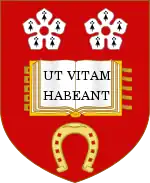 |
Leicester, granted 3 April 1922 to predecessor University College, Leicester
Escutcheon: Gules, an open book strapped proper and buckled and inscribed with the words "Ut Vitam Habeant" in letters Or, between in chief two cinquefoils pierced ermine and in base a horse shoe also Or. The open book symbolises learning. One of the cinquefoils represents the city of Leicester, the other the county of Leicestershire. The horseshoe represents the county of Rutland. The demi-gryphon on the crest is taken from the arms of benefactor Thomas Fielding Johnson.[32] The institution was called Leicestershire and Rutland University College from 1921 to 1927 and University College, Leicester from 1927 to 1957. |
 |
.svg.png.webp) |
Liverpool, granted 30 October 1903
Escutcheon: Azure an open book Argent inscribed "FIAT LUX" in letters Sable bound and on the sinister side seven clasps Or between three cormorants otherwise called Livers wings elevated of the second each holding in the beak a branch of seaweed called Laver proper. Note: granted in 1903 according to Fox-Davies,[12] but recorded as in use by University College, Liverpool in 1894 by Woodward.[13] | |
 |
Manchester, granted 10 May 2010[34]
Escutcheon: Per fess nebuly enhanced Bleu-celeste and Purpure issuant in chief a sun in Splendour or in base three bees volant Proper. The arms combine elements of the two predecessor institutions University of Manchester Institute of Science and Technology (UMIST) and the Victoria University of Manchester. The crowned lion on the crest appeared on the UMIST coat of arms, while the sun against a blue background belonged to the Victoria shield, symbolising growing enlightenment. The (worker) bees symbolise the university's connection with the city of Manchester and also appear on the UMIST arms. |
 |
 |
Newcastle, granted 28 January 1938 (as King's College, Durham)[35]
Escutcheon: Azure, a cross of St. Cuthbert argent; on a chief of the last a lion passant guardant gules. Note: King's College, Durham became the University of Newcastle upon Tyne in 1963. | |
 |
Nottingham, granted 15 April 1948[36]
Escutcheon: Barry wavy of six argent and azure, a cross moline gules; on a chief of the last an open book proper clasped Or inscribed with the words 'Quaerenti Ostium', in Roman characters sable between two domed towers also proper, that to the dexter ensigned with an increscent of the first and that to the sinister with an estoile, also Or. The Latin text on the book (of knowledge) Quaerenti Ostium means 'an entrance for the seeker'. | |
 |
Queen's, Belfast, granted 24 March 1910 by Nevile Wilkinson, Ulster King of Arms.[38]
Escutcheon: Per saltire Azure and Argent on a saltire Gules between in chief an open book and in base a harp both Proper in dexter a hand couped of the third and in sinister a seahorse gorged with a mural crown of the fourth an imperial crown of the last. The crown represents the link to Queen Victoria and the university's early link to the former Queen's University of Ireland. St Patrick's saltire references Ireland and was also found on the arms of the former institution. The book represents learning, the seahorse Belfast, the harp Ireland and the red hand Ulster.
| |
 |
Reading, granted 7 August 1896 (as Reading University Extension College)[39]
Escutcheon: Per fesse gules and sable, in chief three escallops fessewise or and in base a cross engrailed argent, a rose of the first thorned and seeded proper. The Reading University Extension College became the University of Reading in 1926. The three scallop shells in the chief are derived from the coat of arms of Reading Abbey. The engrailed cross is adopted from the arms of Christ Church Oxford the sponsor of the then Extension College. The Lancashire rose references the arms of the royal county of Berkshire.[40][41] | |
 |
Sheffield, granted June 1905
Escutcheon: Azure an open book Proper edged Gold inscribed with the words "DISCE DOCE" between in fess two sheaves of eight arrows interlaced saltireways and banded Argent in chief an open crown Or and in base a rose also Argent barbed and seeded Proper. The open book inscribed with Disce Doce (Learn and Teach) is self-explanatory. The sheaves of eight silver arrows are from the arms of the city of Sheffield. The gold crown is a 'crown of success' i.e. an emblem of achievemnt and the white rose represents Yorkshire.[42] | |
 |
Southampton, granted 1 March 1, 1948
Escutcheon: Argent, a hart trippant gules; on a chief azure an open book proper, edged and bound or The open book in the chief is a symbol of learning. The hart is a wordplay referencing Henry Robinson Hartley who bequeathed funds to form the Hartley Institution which eventually became the University of Southampton.[44] |
1960s Universities
| Arms | University | Full Achievement |
|---|---|---|
 |
Aston, granted 18 March 1955 to predecessor the College of Technology, Birmingham
Escutcheon: Azure, five lozenges conjoined in bend Or; on a chief argent, an open book proper, bound gules edged Or, between two hammers erect sable. On the chief the book represents learning and the ball-pein hammers the connection with metalwork industry. The mural crown in the crest is used by public bodies. The laurel wreath represents academia and also a link to Birmingham.[45] The five lozenges reference the arms of the city of Birmingham. | |
 |
Bath, granted 15 November 1966
Escutcheon: Azure, a Watt Governor proper above a sword Argent with handle Or between two Gorgon's heads Or. The sword is taken from the arms of the City of Bath, the two Gorgon's heads are the main symbol of the university, taken from a Roman sculpture found in the city. The Watt Governor is a common component in engines and duly represents technology taught at the university; once a merchant's school. The full heraldic achievement can be found displayed on buildings at the university campus.[47] | |
 |
Bradford, granted 20 Feb 1967
Escutcheon: Gules, an open book proper, edged, bound and having seven clasps, between in chief two bugle horns stringed Or and in base a rose argent barbed and seeded proper The white Yorkshire rose on the red background symbolises the West Riding of that county. The bugle horns are taken from the arms of the city of Bradford. The open book represents learning and the seven clasps the quadrivium and trivium of classical education. On the crest the flaming torch represents enlightenment. The white falcon supporters reference the House of York and also link to the sun god Horus.[48] | |
 |
Brunel, granted 12 June 1970
Escutcheon: Azure, a pair of dividers chevronwise proper, in base on a pile re versed Or a lozenge ermine; a chief enarched in the form of a bridge of masonry proper The masonry arch symbolises I. K. Brunel's bridges. The compasses and the cogwheel symbolise technology. The ermine lozenge is an allusion to the Arms of Lord Halsbury, the first Chancellor of the university. The crest with a swan symbolises Uxbridge. |
 |
 |
Dundee, granted to predecessor University College of Dundee, 18 July 1949
Escutcheon: Per saltire Argent and Azure, on a chief Gules a coronet of four fleurs-de-lys (two visible) and four crosses pattee (one and two halves visible) Or. The blue and silver pattern references the Scotish saltire and links also to the arms of the University of St Andrews of which the university was a former college. | |
 |
East Anglia, granted 5 March 1964
Escutcheon: Azure, three ancient crowns Or, in chief a castle of three domes argent, flying from each the banner of St. George, the port sable, portcullis raised Or The castle is taken from the Arms of Norwich. The three gold crowns are incorporated as the traditional emblems of East Anglia, being the crowns of St. Edmund the first King of the East Angles; representing his sovereignty, martyrdom and innocence. | |
 |
Essex, granted 10 December 1963
Escutcheon: Gules, three seaxes in pale, cutting edges upwards, argent, pomels and hilts to the dexter Or, in chief an open book proper edged and bound with seven clasps Or The arms are those of the county of Essex, derived from the Kingdom of the East Saxons, with the addition of an open book to represent learning with seven clasps symbolising the quadrivium and trivium of classical education. The two oak branches on the crest represent the Wivenhoe parkland and the ancient Forest of Essex. On the crest there is a wyvern above an annulet. This is a wordplay of 'Wyvern-O' to represent the site of the university's main campus.[49] |
|
 |
Heriot-Watt, granted 8 August 1958 to predecessor Heriot Watt College
Escutcheon: Per pale, two coats both demidiated; dexter, barry of six or and azure, an oak tree eradicated vert; sinister, argent, on a fess azure between an open book undemidiated, binding gules, in chief proper, and a mullet in base of the second, three cinquefoils of the first. The arms contain elements of those of the Watt and Heriot families. The oak tree and gold and blue bars are from the arms granted to the son of James Watt (also called James). The Heriot arms with the cinquefoils and mullet (star) are also used by George Heriot's School. The book which is added to the Heriot arms, represents learning.[51] | |
 |
Keele, granted 20 June 1950 to predecessor the University College of North Staffordshire,
Escutcheon: Or, on a chevron gules an open book argent, in base a scythe proper; on a chief wavy of the second a Stafford knot between a fleur-de-lys and a fret of the second. The scythe is from the arms of the Sneyd family, who owned the Keele park estate from 1540 to 1949. The Sneyd family motto "Thanke God for All" was also adopted. The shield features the colours red and yellow to represent the County of Staffordshire as well as the Staffordshire chevron. The Stafford knot for Stafford, the Fleur-de-Lys for Burton upon Trent and the Fret depict the historical association with the industry of Stoke-on-Trent. On the crest an open book joins Rodin's Le Penseur, which is represented amid a wreath of laurel vert. |
 |
 |
Kent, granted 1 June 1967
Escutcheon: Per chevron argent and gules, in chief three Cornish choughs proper, and in base a horse rampant argent The white horse of Kent is taken from the arms of the County of Kent (and can also be seen on the Flag of Kent). The three Cornish choughs, originally belonging to the arms of Thomas Becket, were taken from the arms of the City of Canterbury. The Crest depicts the West Gate of Canterbury with a symbolic flow of water, presumably the Great Stour, below it. Two golden Bishops' Crosiers in the shape of a St. Andrews Cross are shown in front of it. The supporters – lions with the sterns of golden ships – are taken from the arms of the Cinque Ports.[53] |
 |
 |
Lancaster, granted 20 May 1966
Escutcheon: Or, a fesse wavy argent charged with two barrulets wavy azure between in chief two roses gules barbed and seeded and in base an open book proper bound and clasped; on a chief gules a lion passant Or. The wavy blue line refers to the River Lune, a prominent geographic landmark of the city of Lancaster. Secondly, the two red roses are symbols of the House of Lancaster (and the county of Lancashire) and are taken directly from the arms of the Lancashire County Council. The open book represents wisdom and the university's purpose as an institution of learning. Lastly, the Lion passant comes from the arms of the Duchy of Lancaster. | |
 |
Loughborough, granted 5 October 1966
Escutcheon: Sable, on a cross engrailed purpure fimbriated argent between in the first quarter a cross composed of the upper and lower limbs of a cross crosslet and the horizontal limbs of a cross formy, and in the fourth quarter a thunderbolt, an ancient lamp, all Or. The official colour of the university is African violet. The coat of arms incorporates symbols relevant to the history of the Loughborough area and of education in general. They are Offa of Mercia's cross (a symbol of the ancient kingdom of Mercia, within whose borders the town now stands), the peafowl from the arms of the Dukes of Rutland and a lamp representing learning and enlightenment. | |
 |
Open, granted 1971, replaced 15 June 2011[55]
Escutcheon: Azure an open Book proper bound Gules and irradiated Or thereon a Television Screen and on a Chief Or two Spools of Recording Tape proper The television screen and tape reels represent the technology initially used to support teaching. The new grant in 2011 removed the television screen, but retained the book and replaced the tape reels with laurel wreaths. The escutcheon featured in the crest is used as a logo by the university. | |
 |
Salford, granted 6 January 2017[56]
Escutcheon: Sable above a demi Sun issuant in base Argent charged with a demi Rose likewise issuant Gules barbed and seeded proper a Chain fesswise throughout enhanced and enarched and a Chief embattled and enarched Argent. On the shield the red rose represents Lancashire, the sun enlightenment and the chain and cogwheel the area's industrial heritage. Likewise the bollards, rope and quayside. The blue wavy line is the River Irwell. The (worker) bees found on the supporters represent Manchester. On the crest the lion represents bravery, strength and valour, the shuttle underneath the hind paw represents industry. The firebasket represents truth and knowledge. |
 |
 |
Stirling, granted 10 June 1967
Escutcheon: Per fess enarched Vert and barr‑wavy Azure and Argent a bow‑arched bridge of seven arches in fess Argent ensigned with a tower of the last, masoned sable, window Gules. between three open books two and one proper, fore‑edges and binding Or The wavy blue and silver lines refer to the River Forth and the bridge to Stirling Old Bridge. The tower references the Wallace Monument and symbolically safety and guardianship. The open books represent learning.[57] | |
 |
Strathclyde, granted 7 December 1964
Escutcheon: Per pale, Gules and Azure, a saltire Argent cantoned between an antique crown in chief Or and three cinquefoils Ermine in the flanks and base; on a chief Or a wave-packet Sable between two open books proper, fore-edges and binding of the First The arms contain elements of those of two predecessor institution the Royal College of Science and Technology and the Scottish College of Commerce. The royal crown and Scottish saltire are from the former and the books representing learning are from the latter. The wave packet linking the books indicates technology. The three cinquefoils and the partial red background of the shield reference the ancient kingdom of Strathclyde and the blue background modern Scotland. The crown signifies both the ancient kingdom and a royal connection through the grant of royal status to then Royal Technical College in 1912.[58] | |
| Surrey, granted 5 October 1966
Escutcheon: Or, three swords palewise, points downwards, gules; on a chief - sable a pale checky azure and Or between two woolpacks argent The chief has woolpacks referring to the arms of the borough of Guildford. The blue and yellow chequers are from the arms of the Earl of Surrey. The three swords are also found on the arms of former institution Battersea Polytechnic,[59] and link to the arms of the city of London. On the crest the stag represents the medieval royal hunting park on which the main campus was built. The key is a heraldic symbol of learning.[60] | ||
.svg.png.webp) |
Sussex, granted 15 March 1962
Escutcheon: Argent, on a chevron per pale Azure and Gules six martlets Or, between in chief two Saxon- crowns and in base a dolphin naiant Sable. The arms of the counties of East Sussex and West Sussex are represented both in the red and blue chevrons and the six martlets. The saxon crowns represent the ancient Kingdom of Sussex. The dolphins in the shield and crest are taken from the arms of Brighton. The pelican supporters represent piety or dedication and books they are standing on education.[62] |
 |
 |
Warwick, granted 5 October 1966
Escutcheon: Quarterly Gules and Sable; In the first quarter, an Elephant statant, on the back a Castle triple towered Or; In the second and third quarters, representations of the two Isotopes of Lithium, that in the second quarter having six and that in the third seven Protons and neutrons in its nucleus, with Electrons in orbit Argent: In the fourth quarter, a Bear and Ragged Staff Argent, muzzled Gules collared and chained Or; On a Chief Argent, a representation of a DNA Double Helix, spirals Azure, lined Gules, with connecting Lines Or. The chief shows a DNA double helix representing science, likewise the atoms of isotopes of lithium in the quarters. The bear and ragged staff represents Warwickshire and the elephant and castle Coventry. The scroll below generally shows the Latin name of the university Universitas Warwickensis.[11] | |
 |
York, granted 20 June 1962
Escutcheon: Azure, on a chevron ermine three books fessewise, each with two clasps downwards, Or. |
 |
1980s Universities
| Arms | University | Full Achievement
|
|---|---|---|
 |
Buckingham, royal charter granted in 1983 Escutcheon: Azure a Pall reversed between in chief two Bucks Heads caboshed Gold and in base three Bars Wavy Argent Note: The university uses the swan (a symbol of Buckinghamshire) of its crest as a logo. | |
 |
Ulster, granted 2 March 1985
Escutcheon: Per fess Gules and Argent a Pale countercharged over all an Ancient Lamp enflamed Or ensigned by a dexter Hand appaumy couped at the wrist Gules all within an Orle countercharged Or and Gules The six alternating red and white panels represent the six counties of Northern Ireland. The red hand is a symbol of the province of Ulster. The lamp represents enlightenment and learning. One of the supporters is an antelope which links to the supporters of the arms of the dukedom of Abercorn. The other supporter is an Irish elk also found as a supporter on the arms of Northern Ireland.[64] |
Post-1992 Universities
| Arms | University | Full Achievement
|
|---|---|---|
 |
Abertay, granted 1953 to predecessor Dundee Institute of Technology[65]
Escutcheon: Parted perfess, in chief tierced. 1st Ermine, a chevron engrailed between three mullets Gules; 2nd Azure, three chevronels Or; 3rd Argent, a spray of oak Proper fructed Or between three pheons Azure, in base Azure, a pot of three flowering lilies Argent between two flanches Or each charged with a book of Gules The pot of lilies is taken from the arms of the City and Royal Burgh of Dundee, and the two books are included to mark the educational nature of the institute. The arms of the Baxter family and those of the Dalgleish family (both benefactors) are shown in the top left and top right segments respectively, while the chevrons between them represent technical work. | |
 |
Anglia Ruskin, granted at unknown date
Escutcheon: The blue border represents the East Anglian region, surrounded by the sea. The sheaves of wheat represent agriculture. Gold roundels represent industry. The heron is the main symbol of the university, shown in the arms as both sinister and dexter supporters. The Crowns symbolise East Anglia. | |
| Birmingham City, granted at unknown date
Escutcheon: | ||
 |
Bournemouth, granted in 1992
Escutcheon: The talbots, the heraldic beasts on the shield, represent the location of the main campus. The crowns denote the three Saxon crowns of the Kingdom of Wessex, and the nearby boroughs. The blue represents the nearby sea, reflecting the location of the university, on the Jurassic Coast of Dorset. The red dragon as supporter represents Dorset, and the scroll represents learning. | |
 |
Central Lancashire, granted at unknown date
Escutcheon: Per chevron invected of two points downwards Azure and Or in chief a Paschal Lamb couchant Argent nimbed and supporting a Cross staff Or flying therefrom a Pennon Argent and in base a rose Gules barbed and seeded proper The paschal lamb is taken from the arms of the city of Preston. The red rose represents Lancashire.[67] | |
 |
Coventry, granted at unknown date
Escutcheon: The phoenix represents the revival/rebirth of Coventry following the city's devastation during the Second World War.[68] The phoenix is also a supporter of the arms of the city of Coventry. | |
.svg.png.webp) |
Cranfield, granted 1 January 1971 to predecessor Cranfield Institute of Technology
Escutcheon: Per chevron barry undy Or and Azure and Azure in base a Torch of three branches Or inflamed proper The university states that "the ‘bars undy wavy’ in the chief of the shield in combination with the cranes allude to the university's name, Cranfield, which etymologically derives from ‘cranuc-feld’, meaning a field frequented by Cranes. The three-branched torch in the base refers to learning and knowledge in the sciences of Engineering, Technology and Management. The astral crown in the crest alludes to the College of Aeronautics and also commemorates The Lord Kings Norton as Chancellor, having regard to his contribution to the development of aeronautical research and his links with the college. The keys represent gaining of knowledge by study and instruction and the owl represents knowledge in the widest sense."[69] |
 |
 |
De Montfort, granted to predecessor, Leicester Polytechnic 8 July 1990 Escutcheon: Per fess wavy Gules and Azure Or in chief a Lion passant and in base a Cinquefoil pierced of the field countercharged The book in the crest represents learning. The lion supporter and cinquefoil are taken from the arms of the city of Leicester.[70] The lion (passant) in the chief references the lion (rampant) of the arms of Simon de Montfort. | |
.svg.png.webp) |
Derby, granted 21 December 1995
Escutcheon: Azure an Armillary Sphere Or on a Chief Gules a Cross Potent Quadrate Argent charged with a fountain proper between two Stags' Heads Caboshed Argent |
 |
 |
East London, granted 25 April 2013[71]
Escutcheon: Azure a Torch enflamed Or enfiling an Annulet embattled on the outer edge Argent between two Keys in pile the wards upwards and outwards Or on a Chief wavy Argent three Acorns proper. The supporters are a pair of phoenixes. They represent the rebuilding of the founding institution West Ham Technical Institute in 1900 following a fire.[72] | |
 |
Edinburgh Napier, granted to predecessor Napier Technical College 7 June 1965; as Napier University 7 April 1993
Escutcheon: Tierced in pairle reversed; 1st, Argent, a castle triple-towered parted per pale Gules and Sable upon a rock Proper, roofs counterchanged, masoning, two windows and port of the First; 2nd; Gules, on a bend Argent three crescents Azure; 3rd, Argent a saltire engrailed Gules cantoned between four roses of the Second, barbed Vert and seeded Or. The arms of John Napier of Merchiston (1550-1617), the inventor of logarithms, whose birthplace, Merchiston Castle, is now part of the university are in the top right part of the shield. The arms of the City of Edinburgh, as founders of Napier College, are in the top left. The lower part of the shield shows the modern arms of the Napier family. | |
 |
Glasgow Caledonian, granted 31 May 1993
Escutcheon: Per chevron Azure and Argent a saltire Ermine cantoned between in chief two keys in saltire wards uppermost and outwards Or, and in base issuant from a mound Vert an oak tree Proper and on the top of the tree a red breast also Proper; on a chief Or a book expanded Proper, binding and fore-edges Gules, between two lions combatant Sable, armed and langued Gules The arms combine elements of two founding colleges: Glasgow College of Technology (later Glasgow Polytchnic) and The Queen's College, Glasgow. The oak tree and robin refer to St. Mungo the patron saint of Glasgow and were borrowed from the arms of Glasgow Polytechnic, likewise the book of knowledge. The saltire ermine and the crossed keys (intended to represent the "unlocking" of the book of knowledge) were taken from the arms of The Queen's College. | |
 |
Greenwich, granted 7 December 1990 to the university's predecessor institution Thames Polytechnic, to mark the centenary of the original foundation as Woolwich Polytechnic in 1890 Escutcheon: Barry wavy of six Argent and Azure upon a Pale Sable a Gun Barrel erect surmounted on the breach by a Lion's Face Or on a Chief Gules an Open Book proper bound Or between on the dexter a Cog Wheel and on the sinister a Capital of a Doric Column both Or Many elements of the arms reference those of predecessor institutions. The blue wavy lines represent the Thames river. The cannon is a symbol of the Royal Arsenal where many students historically were employed. The cogwheel represents engineering and technical subjects. The capital of a doric column refers to the Hammersmith College of Art and Building whose Departments of Architecture, Landscape Architecture and Surveying merged with Woolwich Polytechnic in 1969. The book is a symbol of learning. The owl in the crest represents wisdom. The white horse supporter is that of the county of Kent referring to Dartford College. The lion supporter references the lion found on the arms of the former London County Council.[73] | |
 |
Hertfordshire, granted 1992
Escutcheon: Purpure a Fess conjoined to two Flaunches Argent between in chief a Representation of the Constellation Perseus consisting of six Mullets and in base an Oak Tree couped and fructed Gold The shield is charged with an oak tree taken from the coat of arms of the former Hatfield Rural District, the constellation Perseus (containing the binary star Algol) and a representation of the letter "H" recalling the emblem of the former Hatfield Polytechnic. The crest, a Phoenix rising from an astral crown, represents the university's evolution from a technical college training apprentices for the aviation industry. The two harts supporting the shield represent the county of Hertfordshire, with the covered cups referring to A.S. Butler, who donated the land upon which the original campus was built |
 |
| Huddersfield, granted 11 January 1979 to predecessor institution Huddersfield Polytechnic Escutcheon: On an open Book proper bound Sable on the dexter page the word Trivium and on the sinister the word Quadrivium in letters Sable on a Chief of the last a Tower between two Rams passant Argent The open book represents learning and the Latin text thereupon is the quadrivium and trivium of classical education. The tower represents landmark Castle Hill. The rams are symbols of the town and refer to the Ramsden family, property owners of the locality. | ||
| Kingston, granted at unknown date
Escutcheon: | ||
 |
Lincoln, granted 12 May 2011[74]
Escutcheon: Argent a Pall reversed between in chief two closed Books Azure garnished Or and in base a Garb Azure banded Or. On the arms the blue reversed pall represents regional waterways and also the joining of local institutions to form the university. The books represent knowledge and the wheatsheaf agricultural heritage. On the crest the tower is a symbol of Lincoln cathedral and the falcon of strength and flight. The fleur-de-lys held by the swan supporters represent the city of Lincoln. The swans reference Saint Hugh of Lincoln.[75] | |
 |
Liverpool John Moores, granted 16 September 1989
Escutcheon: Barry wavy of six Argent and Azure three Cormorants rising wings addorsed Sable sans legs beaked Or and each enfiling a Mercantile Crown Or The three cormorants ('liver birds') and crowns represent the city of Liverpool and its mercantile traditions. The waves symbolise a maritime connection. The cormorant and sea waves both feature in the arms of the city of Liverpool. The owl in the crest represents wisdom. It is a sea owl with the lower part of the body represented as a fish, a traditional heraldic convention used to symbolise a maritime connection. |
 |
| London South Bank, granted 1970 to predecessor Polytechnic of the South Bank
Escutcheon: Two Thames barges: a pentagon surrounded by five other pentagons | ||
| Manchester Metropolitan, granted 1991 to predecessor Manchester Polytechnic
Escutcheon: The symbols in the chief each consist of up to six 'spade-irons' (metal blades of spades) and are symbols of hard work and link to Manchester's cultural and physical landscape. The chequerboard symbolises opportunity and the variety of academic disciplines available. The flame represents a burning enthusiasm for learning. In the crest the lion references the arms of the city of Manchester. Likewise the globe covered with bees. The latter representing industriousness and the former internationalism and a global student body. The antelope supporters, breathing flames of knowledge, reference the Manchester arms but are outward looking in pursuit of knowledge and opportunity.[76] | ||
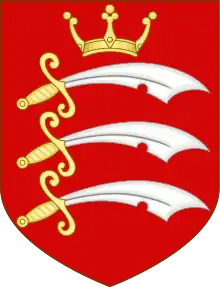 |
Middlesex, adopted from arms of Middlesex County Council granted 7 November 1910
Escutcheon: Gules three Seaxes fessewise in pale proper pommelled and hilted Or points to the sinister and cutting edge upwards in chief a Saxon Crown of the last The arms are based on the traditional arms of the Kingdom of the East and Middle Saxons, as used by the Essex and Middlesex counties. In the case of Middlesex, a Saxon crown was added at the time of the grant. | |
.svg.png.webp) |
Northumbria, granted 9 November 1995
Escutcheon: Per fess enarched and embattled Argent and Gules in chief two Castles triple-towered also Gules and in base an open Book Or The university states 'Northumbria's shield contains two triple-towered castles, representing the City of Newcastle upon Tyne, and an open book which represents learning. The arched line of battlements dividing the shield refers to the Roman Wall, a historic feature of Northumberland. Whilst the curve of the arch reflects the King George the Fifth Bridge over the River Tyne, more generally the bridge alludes to the university's role in the transmission of knowledge to, and strong links, with the society in which its located.'[77] The crest is a lion grasping a flaming torch which is an emblem of learning, also a trident as the emblem of the old god of the River Tyne. The supporters are seahorses referencing the arms of Newcastle upon Tyne but with the addition of crowns around their necks, alluding to the roman Wall and holding tridents of the River Tyne. |
 |
| Nottingham Trent, granted at unknown date
Escutcheon: |
||
 |
Plymouth, granted 2008
Escutcheon: The two gold open books represent the university's focus on learning and scholarship. The scattering of small stars represents navigation, which has played a key role in the history of the city and the university. The scallop shells in gold represent pilgrimage, a sign of the importance of the departure of the Pilgrim Fathers from the Barbican aboard the Mayflower in 1620. A Pelican and a Golden Hind support the shield and reflect both the original and later, better known, name of Sir Francis Drake's ship. The crest contains the Latin motto Indagate Fingite Invenite ('Explore Dream Discover'), a quote from Mark Twain, reflecting the university's ambitions for its students and Plymouth's history of great seafarers. | |
| Portsmouth, granted to Portsmouth Polytechnic 8 June 1982, transferred by Royal Licence to the University of Portsmouth 17 October 2017.[78][79]
Escutcheon: Azure on a pale between two cotises engrailed on the outer edge argent three crescents azure each ensigned by a rose gules seeded gold The arms combine the Hampshire rose with the Portsmouth crescent on a central white band. The blue field is intended to represent the sea and the vertical white band the path of learning. The crest depicts a sea-centaur bearing a flaming torch. In mythology Cheiron the centaur was responsible for the education of many characters. A sea-centaur has never before been used in a heraldic device and thus provides a unique creature which appropriately combines the sea and learning. The creature is depicted with a flaming torch as a further allusion to education. The tinctures of the crest reflect those of the escutcheon in the interest of unity of design. The supporters, a maritime version of the royal supporters ie lion and unicorn, are also a reference to the arms of the city of Portsmouth. | ||
 |
Robert Gordon, granted 14 May 1993
Escutcheon: The three boar heads are taken from the arms of Clan Gordon. The tower is taken from the arms of Aberdeen. The wavy pale has symbols for engineering (wheel), learning (torch) and finance (bezant). | |
| Sheffield Hallam, granted at unknown date
Escutcheon: The two white roses of York on the escutcheon and that also on the crest represent Yorkshire. The book represents learning. The arrows are a symbol of the city of Sheffield and are found on the latter's coat of arms. The sheaves, although representing growth, here shown on a green background ie a field, are part of a wordplay on the city's name. The same wordplay is made on the city's arms.[80] |
 | |
| Staffordshire, granted at unknown date
Escutcheon: The reversed pall ('inverted Y') represents the conjoining of various institutions to form the current university. The open book represents learning. The Stafford knot on both the escutcheon and crest is a traditional symbol of the county of Staffordshire. The red and white colouring link to the Stoke-on-Trent city arms. The owl represents Athena goddess of wisdom. The swallow supporters represent the students and knowledge they bring from elsewhere in the world.[81]) | ||
| Sunderland, granted at unknown date
Escutcheon: The university states that on the crest the ship represents a maritime connection. On the escutcheon chief are bishop's mitres referencing the localities of Bishopwearmouth and Monkwearmouth and St Peter's keys. The sun represents the light of learning and is a wordplay on Sunderland. Eight gyrons behind the sun reference many courses of study offered. The gryphon supporter signifies wisdom and looks to the future. The lion is adopted from the coat of arms of County Durham.[82] | ||
| Teesside, granted at unknown date
Escutcheon: The shield includes a white rose of Yorkshire, a ship representing the town's maritime heritage and a book (learning). The crest includes an anchor, also a maritime reference. | ||
.svg.png.webp) |
Westminster, granted at unknown date
Escutcheon: Purpure a portcullis chained Argent, on a chief of the Second an open book Proper, bound of the First, inscribed with the word "Veritas" between two roses Gules each charged with another Argent barbed and seeded Proper. The portcullis is the symbol of Westminster whilst the open book symbolises learning. The Tudor roses, a royal emblem, symbolise the UK monarch who traditionally acts as patron of the university. |
 |
| West of England, granted at unknown date
Escutcheon: The arms are derived from those of a predecessor institution St Matthias College (itself formerly Gloucester and Bristol Diocesan Training Institution for School Mistresses). The crest links to another predecessor institution, the Merchant Venturers' Navigation School. The firebasket in the ship's rigging represents guidance, hope and a desire for learning. The unicorn supporter is taken from the arms of the city of Bristol. The other supporter is a sea stag and is from the arms of the former county of Avon. Both supporters wear on the neck the crown of King Edgar, referencing the monarch's association with Bath Abbey and hence the region. The supporters' epaulets symbolise fountains of knowledge and learning. Both supporters also hold an apple tree: the tree of knowledge.[83] | ||
 |
West of Scotland, granted 28 March 2017
Escutcheon: Or, two torches saltireways Sable, enflamed Gules cantoned between in chief an abbot's mitre Proper, in base a terrestrial globe Proper and in the flanks two books Proper, bindings and fore-edges Gules, the dexter charged with a mullet Gules and the sinister charged with a bell Or, with a base branch of laurel in bend and a branch of holly in bend sinister conjoined Proper | |
 |
Wolverhampton, granted October 1994[84]
Escutcheon: Between two Chevrons Couped inverted and conjoined, three pairs of Keys Saltire Wards upwards and outwards, two in chief and one in base Azure In the crest there is the sun representing enlightenment and a book representing learning. The three crossed keys in the escutcheon link to the crossed keys on the crest of the arms of the city of Wolverhampton as well as being a symbol of learning. The chevrons form the initial 'W' of Wolverhampton. One of the supporters is engineer Thomas Telford, the other Wulfrun the Anglo-Saxon founder of the city.[85] |
21st century universities
| Arms | University | Full Achievement |
|---|---|---|
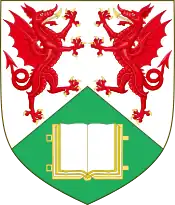 |
Aberystwyth, granted 7 May 1938 to predecessor University College Wales[86]
Escutcheon: Per chevron Or and vert in chief two dragons combatant gules, armed and langued azure, and in base an open book proper The two red dragons symbolise the optimism of Victorian north and south Wales and the open book symbolises the world of learning. The phoenix in the crest represents rebuilding after a fire in 1885.[87] | |
 |
Bangor
Escutcheon: The arms are derived from those Llywelyn prince of Gwynedd, also found in the Royal Badge of Wales. The university however has inserted a 'pale' (vertical strip) with an additional (fifth) lion, in this case 'rampant'. There is a similarity also to the arms of Owain Glyndŵr. However four Bangor lions are 'passant' (walking) rather than rampant as seen on the former's arms. The pale distinguishes the arms from those of Wrexham Glyndŵr University. | |
| Birmingham Newman, granted 6 November 1987 to predecessor Newman College of Education
Escutcheon: In the chief there are two St. Chad's crosses. Chad represents the ancient kingdom of Mercia as well as the religious foundations of the university. The wavy line is taken from John Henry Newman's own arms. The wolf is a wordplay on the name Wulfwine, who is the area's first recorded landowner. | ||
 |
Birmingham (University College), granted 20 September 1962 (to the Lord Mayor, Aldermen and Citizens of the City of Birmingham for the use of The Birmingham College of Food and Domestic Arts); transferred by royal licence 22 December 2014[88]
Escutcheon: Per chevron Gules and Or a Chevronel Sable between in chief two Roundels Argent the dexter charged with a Garb and the sinister with a Boar's Head couped at the neck proper and in base a Flame of Fire between two Sprigs of Bay the stems crossed in base proper tied with a Riband Gules. | |
 |
Bishop Grosseteste, granted 26 June 1969 to predecessor Bishop Grosseteste College of Education
Escutcheon: Azure, a bend ermine; over all on a cross moline Or a leopard's face gules jessant-de-lys vert The ermine diagonal is a reference to the Roman road between London and Lincoln Ermine Street. The central figure of the arms is a jessant-de-lys - a leopard’s face with a fleur-de-lys in the open mouth. The fleur-de-lys is from the arms of the city of Lincoln. The cross moline is from arms of Robert Grosseteste. The bishop's crozier which is part of the crest also references the latter. The lion references the arms of the Sibthorp family, early patrons of the then college.[89] Note: The university uses part of the escutcheon of the arms of the diocese of Lincoln, as its logo. | |
 |
Bolton, granted 5 March 1990 to predecessor Bolton Institute of Higher Education[90]
Escutcheon: Or Fretty Gules overall three Moorcocks two and one Sable a Bordure Gules charged with eight Pomegranates Or seeded Gules In the full arms, the crest features the red rose, the symbol of Lancashire, placed on an elephant, taken from the arms of Bolton. | |
 |
Buckinghamshire New, granted to predecessor institution i.e. Buckinghamshire Institute of Higher Education 4 January 1998 Escutcheon: Murray two Haunches vert fimbriated and conjoined to a Barrulet dancetty of two points downward Argent between in chief a Swan proper gorged with a Coronet and holding in the dexter foot a Torch Or enflamed proper and in base a like Swan contourny holding in the sinister foot a Botcher's chisel Or the blade proper The swan is a symbol of Buckinghamshire. One swan holds in its foot a torch a synbol of enlightenment and education.[91] Another swan holds a chisel linked to the local furniture industry and a craft once known as bodging. Note: the university logo is modification (reduction) of the above |
 |
 |
Canterbury, Christ Church, granted at unknown date
Escutcheon: Per pale bleu celeste and gules four cross crosslets argent one and two and one a canton argent fimbriated sable charged with a cornish chough proper The red-billed (Cornish) chough is from the arms of Thomas Becket (and the city of Canterbury).[92] | |
 |
Cardiff, granted 1988 to University of Wales College Cardiff Escutcheon: The chevronels in the arms refer to the arms of the de Clare family, who were feudal lords of Glamorgan. The book is a symbol of learning. The crescent and annulet represent the two former institutions i.e. University College Cardiff and University of Wales Institute of Science and Technology that created the current university. | |
 |
Cardiff Metropolitan, granted at unknown date Escutcheon: Motto: Gorau meddiant gwybodaeth (The most valuable possession is knowledge) The dragon in the crest is the symbol of Wales | |
 |
Chester, granted to predecessor Chester Diocesan Training College 5 July 1954
Escutcheon: Argent, on a cross gules a garb Or, in the first quarter in front of two swords in saltire proper, hilts and pomels gold, an open book also proper, clasped also gold The open book is a symbol of learning, The golden wheatsheaf is from the arms of the city of Chester and the county of Cheshire. The crossed swords are also taken from these arms. St George's cross represents England. On the crest the bishop's mitre references the university's foundation as an Anglican teacher training college.[93] |
|
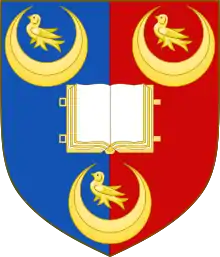 |
Chichester, granted at unknown date
Escutcheon: The book represents learning. The martlets and the colours refer to arms of the counties of East Sussex and West Sussex. | |
 |
Edge Hill, granted 24 January 2007[94] Escutcheon: The university's origins are represented by the three red roses of Lancashire in the shield and by the Liver bird in the crest, which refers to its original location in Liverpool. The liver bird holds a quill as a symbol of learning. The sun represents enlightenment. The colours heliotrope, gold and green found in the shield were used historically by the women's suffrage movement and reflect a commitment to equality and the university's founding as a female teacher training college.[95] | |
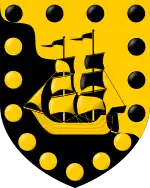 |
Falmouth, granted 14 October 2014
Escutcheon: The arms depict a Falmouth packet ship demonstrating Falmouth's connection to the rest of the world. Atop the coat of arms is a crest which depicts a Cornish chough holding a paintbrush, pen and pencil signifying that Falmouth University is truly a specialist institution of the arts. Just below this is a reference to Pendennis Castle. |
 |
 |
Gloucestershire, granted 17 May 2002
Escutcheon: Three Chevronels interlaced in base Gules on a chief Azure a Cross formy Argent between two open books proper bound Or Within the chief, which is identical to that of the borough of Cheltenham, the books refer to learning and the cross to Edward the Confessor who once owned property in the area. The chevronels refer to the de Clare family, who were the ancient Earls of Gloucester. The horseshoe in the crest reference the arms of the county of Gloucestershire. The two wavy lines in the base represent the rivers Wye and Severn. The stags used as supporters represent the Forest of Dean.
|
 |
 |
Harper Adams, adopted from arms of the university's founder with new grant 2 May 2018[96]
Escutcheon: Azure three Cats-a-Mountain passant guardant in pale Ermine two Flaunches Or gutty Azure The arms were those of brothers Joseph Harrison Adams and Thomas Harper Adams, the latter being the founder of Harper Adams Agricultural College. | |
| Hartpury, granted 25 Novemeb 2019[97]
Escutcheon: | ||
 |
Highlands and Islands, granted 9 May 2012[98]
Escutcheon: Purpure, a compass rose Argent and Sable, in chief a fleur-de-lys Or between two open books Proper binding and fore-edges Or, a bordure Argent charged of thirteen hazel leaves Vert The books represent learning, a compass with fleur-de-lys at north represents the university's location. The 13 hazel leaves, indicating wisdom in Celtic tradition, represent the 13 constituent academic institutions.[99] | |
 |
Imperial, granted 6 June 1908, when a college of the University of London[14]
Escutcheon: Per fesse in chief the Royal Arms of the United Kingdom of Great Britain and Ireland, in base or, an open book proper inscribed with the word "Scientia". The university describes the arms as follows: 'the College arms are simple, confined to a shield, and display the Royal Arms together with a book representing knowledge'.[101] Note: The college became independent from the University of London in 2007. | |
 |
Law, granted 5 September 1967 to predecessor the College of Law
Escutcheon: Ermine, on a cross gules a sword sheathed, point upwards, surmounted by an open book proper bound clasped and edged Or; on a chief gules, on a pale ermine between a pair of scales and a portcullis. chained, a Saxon crown Or | |
 |
Liverpool Hope, granted 29 April 2010[102]
Escutcheon: Gules a Cross engrailed of one point on each limb Argent surmounted by an open Book proper bound Azure and in the first quarter a mullet radiated Argent. |
 |
| London, Arts, granted 1998 to predecessor the London Institute
Escutcheon: |
||
| London Metropolitan, originally granted to London Guildhall, which merged with North London in 2002 Escutcheon: | ||
 |
Northampton, granted at unknown date
Escutcheon: The arms feature a symbol of the (demolished) Northampton castle, referencing the town's arms. Two open books in the chief symbolise learning. The River Nene is represented by a wavy blue line both on the shield and the base. The sinister (left) supporter is a lion rampant representing the town. The dexter (right) supporter is a bull with a gold chain representing the county of Northamptonshire. Both supporters have footstools of the aforementioned castle. The crest is a roebuck which is from the arms of the Worshipful Company of Leathersellers with whom the university has a long association. The cogwheels in the crest represent technical education. The Tudor rose held by the roebuck also represents Northamptonshire.[103] |
 |
 |
Plymouth Marjon, granted 18 September 1925 to predecessor the College of St Mark and St John
Escutcheon: Argent, two swords in saltire, points upwards, between four fusils gules; on a chief per pale azure and of the second, to the dexter a winged lion sejant guardant Or resting the dexter fore paw on an open book proper, and to the sinister a Paschal Lamb also proper | |
 |
Queen Margaret, granted 24 January 2001
Escutcheon: Azure, an ancient crown Argent, on a chief of the Last a book expanded Proper binding and fore-edges Vert between a cross flory cantoned between four martlets Or and a castle triple-towered and embattled Sable, masoned of the Second and capped with three fans Gules, windows and portcullis shut of the Last. The crown is a symbol of Queen Margaret. On the chief there is a castle representing Edinburgh, a book representing knowledge and a cross with four martlets. The latter symbolise learning and the former the canonisation of (Saint) Margaret.[104] | |
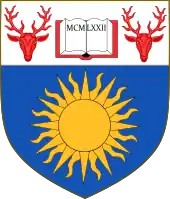 |
Richmond, granted at unknown date
Escutcheon: The sun represents enlightenment and learning. The book is a reference also to the latter. The stags heads refer to Richmond Park. | |
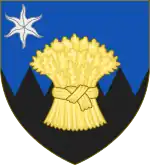 |
Royal Agricultural, granted 20 September 1956 to predecessor the Royal Agricultural College
Escutcheon: Per fess dancetty azure and sable a garb Or in dexter chief an estoile representing the star Sirius argent |
|
| St Mary's, Twickenham, granted at unknown date
Escutcheon: |
||
| Solent, granted 2020
Escutcheon: The university states "The shield depict[s] the Solent and Isle of Wight in a simple geometric design to highlight the University's origins and location. The crest pictures two Northern Gannets fencing, which reflects the University's longstanding connection to maritime and the Solent. The supporters are adaptations of the 'Warsash Dragon', which represent the University's...maritime education."[106] | ||
| South Wales, granted at unknown date
Escutcheon: The shield features a bridge representing Pontypridd and words 'Cofia Ddysgu Byw' meaning 'Remember to Learn to Live' which was the motto of predecessor institutions. The sinister supporter and also crest dragon represents Wales. The dexter oriental dragon represents the university's openness to the world. | ||
 |
Swansea, granted 1921 to predecessor University College, Swansea (Wales)
Escutcheon: The hammer, pickaxe and anchor represent Swansea's industrial and maritime heritage, while the book represents academia. The dragon represents Wales |
 |
| Wales Trinity Saint David, granted at unknown date
Escutcheon: | ||
| Winchester granted 2008
Escutcheon: The crest is a three towered castle taken from the arms of the city of Winchester. The chequered pattern of the shield is from the arms of King Alfred and reference the former name of the university. The chief has a book to represent learning and two lions also from the arms of the city of Winchester. The supporters are white Hampshire hogs holding in their mouths red roses. The hogs represent the county and roses also appear in the county arms and those of William of Wykeham.[107] | ||
| Worcester, granted to Worcester College of Higher Education 18 July 1988. Transferred by Royal Licence to University of Worcester 26 June 2006.[108]
Escutcheon: The escutcheon has blue waves as symbol of the River Severn. The chief has two Worcestershire pears and a wheatsheaf representing agriculture of the region. The crest depicts mythical Sabrina of the River Severn and also two bullrushes representing the university campus on both banks. The supporters, swans holding pomegranates, are symbols of the river as well as persistence and regeneration. | ||
 |
Wrexham Glyndŵr granted 16 February 2009[109]
Escutcheon: The similar arms of Owain Glyndŵr show 'rampant' lions. The university's arms however have 'passant' (walking) lions. These are also the arms of the ancient kingdom of Gwynedd, adopted too by Bangor university and found in the Royal Badge of Wales. The lions support books representing learning while the shield is divided 'dancetty' for heraldic difference. |
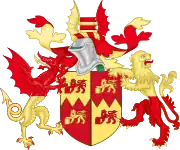 |
 |
York St John granted 12 August 1981 to predecessor the College of Ripon and York St John
Escutcheon: Argent on a Saltire Vert two Keys in saltire wards upwards and outwards Or on a Chief per pale Gules and Azure a Bugle Horn stringed Or between two Roses Argent barbed and seeded proper In the chief there are two white roses of York representing the county. The stringed bugle is a reference to the arms of the city of Ripon. The crossed keys, a symbol of access to education also reference the diocese of York. |
Arms of constituent colleges
Cambridge
| Arms | College | Full Achievement |
|---|---|---|
 |
Christ's, confirmed in 1575
Escutcheon: Quarterly, first and fourth, Azure three fieurs-de-lys, two and one, Or; second and third, Gules three lions passant guardant in pale Or; all within a bordure compony argent and azure.
[110] | |
 |
Churchill
Escutcheon: Quarterly: 1st and 4th, Sable a lion rampant Argent, on a canton of the second a cross Gules (Churchill); 2nd and 3rd, quarterly Argent and Gules a fret Or, over all on a bend Sable three Escallops of the first (Spencer); over all in the centre chief point (as an augmentation of honour) an escutcheon Argent charged with the cross of Saint George in the centre point an open book Argent.[111] | |
 |
Clare, confirmed in 1684
Escutcheon: Or, three chevronels gules, impaling Or, a cross gules; all within a bordure sable guttee d'Or. [112] | |
 |
Clare Hall, granted 1984[113]
Escutcheon: Chevronny Or and Gules on a chief Sable five goutties three and two Argent. [114] | |
 |
Corpus Christi, granted 23 December 1570
Escutcheon: Quarterly 1st & 4th Gules a pelican in her piety Argent vulning her breast Proper 2nd & 3rd Azure three lilies two and one Argent. [115] | |
 |
Darwin, granted 5 January 1966
Escutcheon: Argent, on a bend gules cottised vert between two mullets each within an annulet gules three escallops or (for Darwin) impaling Per fess dancetty azure and gules, a caduceus between in chief two roses Or (for Rayne); all within a bordure Or. | |
 |
Downing, granted 13 April 1801
Escutcheon: Barry of eight argent and vert, a griffin segreant Or within a bordure azure charged with eight roses of the first, barbed and seeded proper. | |
 |
Emmanuel, granted 13 April 1801
Escutcheon: Argent, a lion rampant azure, armed and langued gules, holding in the dexter forepaw a laurel wreath proper, in the mouth a scroll [of the second] inscribed EMMANUEL in letters Or. | |
 |
Fitzwilliam, granted 1966.[119]
Escutcheon: Lozengy argent and gules; a chief of the Arms of the University of Cambridge. | |
 |
Girton, granted 14 February 1928.
Escutcheon: Quarterly vert and argent, a cross fiory counterchanged between in the first and fourth quarters a roundel ermine and in the second and third quarters a crescent gules. | |
 |
Gonville & Caius, granted 1575.
Escutcheon: Argent, on a chevron between two chevronels indented sable three escallops Or, impaling Or, semee of flowers gentil, in chief a sengreen above two serpents erect and respecting one other all proper, the serpents' tails bound together and resting on a square stone of green marble in base, and between the serpents a closed book sable, edged gules clasped and garnished gold; all within a bordure compony argent and sable. | |
 |
Homerton, granted 22 December 1954.
Escutcheon: Argent, a leopard's face jessant-de-lys sable between three griffins' heads erased gules; on a bordure azure eight open books proper. | |
 |
Hughes Hall, granted 1980.[124]
Escutcheon: Quarterly 1st and 3rd Gules an owl proper Or.; 5th Gules a torch Or; 2nd, 4th and 6th Ermine. | |
_shield.svg.png.webp) |
Jesus, granted 1575.
Escutcheon: Argent, a fesse sable between three cocks' heads erased sable, crested and jelloped gules; all within a bordure of the last charged with eight ducal coronets Or. | |
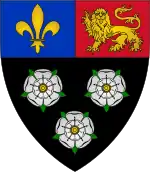 |
King's, granted 1 January 1449.
Escutcheon: Sable, three roses argent; a chief per pale azure and gules charged on the dexter side with a fleur de lis and on the sinister with a lion passant guardant, both Or. [126] | |
 |
Lucy Cavendish, granted 1973.
Escutcheon: Per fess enarched azure and sable, in chief two bars wavy argent, over all issuant from the fess line a water lily also argent slipped and leaved vert, and in base a buck's head caboshed, between the attires a lozenge argent charged with an escallop sable. | |
 |
Magdalene, assumed.
Escutcheon: Quarterly per pale indented Or and azure, on a bend of the second between in sinister chief and dexter base an eagle displayed a fret between two martlets of the first. | |
 |
Murray Edwards, granted 1971[129]
Escutcheon: Sable a Dolphin palewise head downwards to the dexter in chief three Mullets fesswise a Bordure embattled Argent. | |
 |
Newnham, granted 27 February 1923.
Escutcheon: Argent, on a chevron azure between in chief two crosses bottonee fitchee sable and in base a mullet sable, a griffin's head erased Or between two mascles of the field. | |
 |
Pembroke, recorded 1684.
Escutcheon: Barry of ten argent and azure, an orle of five martlets gules dimidiated with paly vair and gules, on a chief Or a label of five points throughout azure. | |
 |
Peterhouse, granted 1575.
Escutcheon: Or, four pallets gules; on a bordure of the last eight open crowns of the first. | |
_shield.svg.png.webp) |
Queens', granted 1575.
Escutcheon: Quarterly of six, first harry of eight argent and gules (for Hungary); second azure semee-de-lis Or a label of three points gules (for Anjou-Sicily); third Agent a cross potent between four crosses couped Or (for Jerusalem); fourth azure semee-de-lis Or a bordure gules (for Anjou); fifth azure crusily two barbels haurient and addorsed Or (for Barr); sixth Or on a bend gules three allerions displayed argent (for Lorraine); the whole within a bordure vert. | |
 |
Robinson, granted 1985.[134]
Escutcheon: Azure in base two Bars wavy Argent over all a Pegasus rampant Or gorged with a Crown rayonny Gules | |
 |
St Catharine's, recorded 1684.
Escutcheon: Gules, a Catherine wheel Or. [135] | |
 |
St Edmund's
Escutcheon: Arms of Henry Fitzalan-Howard, 15th Duke of Norfolk (quarterly of four: Howard, Brotherton, Warenne, FitzAlan) with a canton of St Edmund of Abingdon (Or, a cross fleury gules between four Cornish choughs proper) all within a bordure argent. | |
 |
St John's, assumed.[136]
Escutcheon: Arms of Margaret Beaufort: Quarterly France Modern and England; a bordure compony argent and azure. |
 |
 |
Selwyn, granted 3 December 1964.
Escutcheon: Per pale gules and argent, a cross potent quadrate [per pale] argent and Or between four crosses paty, those to the dexter argent, those to the sinister Or, for the See of Lich field, impaling Argent, on a bend cotised sable three annulets Or, for Selwyn; all within a bordure sable. | |
 |
Sidney Sussex, granted 1675.
Escutcheon: Argent, a bend engrailed sable, impaling Or, a pheon azure. [138] |
 |
_shield.svg.png.webp) |
Trinity, granted 1575.
Escutcheon: Argent, a chevron between three roses gules, barbed and seeded proper; on a chief of the second a lion passant guardant between two closed books, all Or. [139] | |
 |
Trinity Hall, granted 1575.
Escutcheon: Sable, a crescent within a bordure ermine. [140] | |
 |
Wolfson, granted 1973.
Escutcheon: Ermine a chevron gules between in chief two lions passant guardant or, and in base a handbell proper[141] |
Durham
| Arms | College | Full Achievement |
|---|---|---|
 |
Collingwood
Escutcheon: Argent a Chevron between three Stags' Heads erased Sable a Bordure Gules charged with eight Crosses of St Cuthbert of the field. |
 |
 |
Grey
Escutcheon: Gules a Scaling Ladder in bend Argent between two St Cuthbert's Crosses proper. |
 |
 |
Hatfield
Escutcheon: Azure, a chevron Or between three lions rampant Argent, a bordure Ermine. |
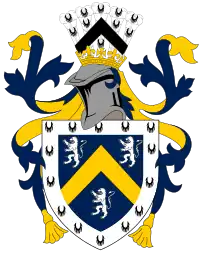 |
 |
John Snow
Escutcheon: Argent a Cross formy quadrate azure, a chief azure thereon a Yorkshire rose argent between two lions rampant Or. | |
 |
Josephine Butler
Escutcheon: Gules on a chevron Or charged with a Cross formy, with cotises invected, between in chief two lions Argent and in base an open book charged with two covered cups. | |
 |
Stephenson
Escutcheon: Argent a chevron between two fleurs-de-lis in chief and a cross fleurettée in gules a chief gules theoreon three lions rampant argent. | |
 |
St Aidan's
Escutcheon: Per chevron Argent and Sable in chief two ancient Northumbrian Crosses Gules in base two Keys in saltire wards upwards of the first. |
 |
 |
St Chad's, granted 17 December 1951
Escutcheon: Vert a Cross potent quadrate Or in chief a Durham Mitre of the last between two Lions rampant Argent. |
 |
| St Cuthbert's, granted 31 May 1957
Escutcheon: Vert a representation of St Cuthbert's Cross proper a Bordure Argent. |
 | |
 |
St Hild & St Bede
Escutcheon: Argent on a Chevron Purpure three Ammonites of the first in base a Cross paty quadrate Gules a Chief Azure thereon between two Lions rampant Or a pale of the last charged with a Cross patonce also Azure. |
 |
 |
St John's, granted 31 May 1957
Escutcheon: Quarterly Argent and Azure in the first and fourth a Cross Formy Quadrate Gules in the second an Eagle wings elevated and inverted Or in the third a Lion rampant Crowned with an Ancient Crown of the last all within a Bordure quarterly of the second and Gold. |
 |
 |
St Mary's, granted 31 May 1957
Escutcheon: Argent a Cross Formy Quadrate Gules a Chief Azure thereon a Durham Mitre Or between two Lilies proper. |
 |
 |
South
Escutcheon: Purpure between an Owl Close Guardant and a Cross Formy Quadrate both Argent a pile inverted conjoined with an orle of the second charged with a Torch enflamed of the first. | |
 |
Trevelyan
Escutcheon: Gules issuant from Water in base barry wavy of four Argent and Azure a Demi-Horse forcene Or in chief three Saint Cuthbert's crosses Argent. |
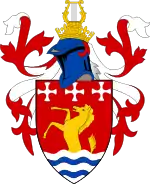 |
 |
University, granted 29 May 1912
Escutcheon: Azure a Cross patonce Or between four Lions rampant Argent on a Chief of the last a Cross of St Cuthbert Sable between two Durham Mitres Gules. | |
 |
Ustinov, granted 10 February 1966
Escutcheon: Ermine a Cross formy quadrate Gules on a Chief indented Sable between three Lions rampant Argent two Lozenges Or.[142]
|
 |
 |
Van Mildert, granted 3 February 1966
Escutcheon: Gules two Scythe blades in saltire in chief the Cross of St Cuthbert Argent. |
 |
Lancaster
| Arms | College | Full Achievement |
|---|---|---|
 |
County College, granted 30 September 1969
Escutcheon: Gules, on three piles, two from the chief and one from the base, Or three roses gules, barbed and seeded proper; over all a chevron azure, and on a chief azure a lion passant Or. | |
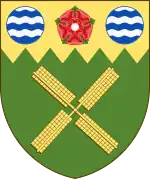 |
Fylde College, granted 1981 (originally the arms of Fylde Rural District Council, 1954-1974)
Escutcheon: Vert the Sails of a Windmill saltirewise Or on a Chief intented of the last a Rose Gules barbed and seeded proper between two Fountains. |
 |
London
| Arms | College | Full Achievement |
|---|---|---|
 |
Birkbeck, granted 31 December 1948
Escutcheon: Chequy Or and sable, on a pale argent a sword gules; a chief of the second, thereon an owl of the third between two antique lamps of the first inflamed proper.[148] |
 |
 |
City, granted 1 August 1966
Escutcheon: Murrey, upon a mount a beacon fired Or; a chief of the Arms of the City of London |
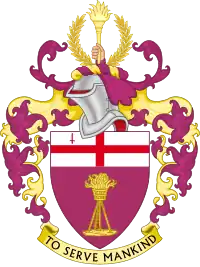 |
 |
Goldsmiths, granted 24 August 1921
Escutcheon: Argent, a cross gules, on an inescutcheon azure a leopard's face Or; on a chief of the third an open book of the field edged and clasped gold | |
 |
King's, granted 21 March 1995
Escutcheon: Or on a Pale Azure between two Lions rampant respectant Gules an Anchor Or ensigned by a Royal Crown proper, on a Chief Argent an Ancient Lamp proper inflamed Gold between two Blazing Hearths also proper. [150] From 1829 to 1989 the arms of George IV were used without a grant, for which the college was fined 20 shillings in 1911. The current arms came into use in October 1989 but were not formally granted until 1995.[151] |
 |
 |
LSE, granted July 1922
Escutcheon: Sable a Beaver passant Or on a chief of the Second two closed Books Purpure clasped leaved and decorated gold.[148] | |
 |
Queen Mary, granted 1996[153] (previous arms assumed 1989)[154]
Escutcheon: The arms contain elements of former constituent colleges Queen Mary College (with the triple crowns originally taken from a sponsor of the college the Drapers Company) and Westfield College |
 |
| Royal Holloway, granted 1985
Escutcheon: The arms of the current institution with the legal name Royal Holloway and Bedford New College, incorporate elements of the former Royal Holloway College and Bedford College. The three crescents in the chief are taken from Thomas Holloway's own coat of arms. The black and gold colours and chequered pattern are taken from the Bedford College coat of arms. The ermine tails (feather-like symbols) are from the former Royal Holloway arms. Placed between two black lozenges in the crest, there is a lamp of learning found also in the Bedford arms. Traditionally, the lozenge is found on the arms of unmarried women (or widows). Here it is a reminder that the two colleges were founded for women. |
||
| Royal Veterinary, granted 1918
Escutcheon: |
||
 |
SOAS, granted 1918
Escutcheon: Argent a cross gules in the first quarter a sword in pale points upwards of the last on a chief also gules an open book proper between a lotus bud on the dexter and a lotus slipped and leaved on the sinister both or.[148] |
Nottingham
| Arms | College | Full Achievement |
|---|---|---|
| Sutton Bonington, granted c.1902, carried forward in 1947 when the former Midland Agricultural College became a college under the University of Nottingham. Escutcheon: Argent a chevron Vert charged with a book Or and proper between two garbs Or, set between three cows Gules. |
||
Oxford
| Arms | College | Full Achievement |
|---|---|---|
 |
All Souls, confirmed in 1574
Escutcheon: Or a chevron between three cinquefoils Gules. | |
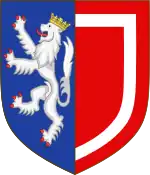 |
Balliol, confirmed in 1574
Escutcheon: Gules an inescutcheon voided Argent impaling Azure a lion rampant Argent ducally crowned Or. | |
 |
Brasenose, confirmed in 1574
Escutcheon: Tierced in pale: (1) Argent, a chevron sable between three roses gules seeded or, barbed vert (for Smyth); (2) or, an escutcheon of the arms of the See of Lincoln (gules, two lions of England in pale or, on a chief azure Our Lady crowned seated on a tombstone issuant from the chief, in her dexter arm the Infant Jesus, in her sinister arm a sceptre, all or) ensigned with a mitre proper; (3) quarterly, first and fourth argent, a chevron between three bugle-horns stringed sable; second and third argent, a chevron between three crosses crosslet sable (for Sutton). | |
 |
Christ Church, confirmed in 1574
Escutcheon: Sable, on a cross engrailed argent, a lion passant gules, between four leopards' faces azure, on a chief or, a rose gules barbed and seeded proper, between two Cornish choughs sable, beaked and membered gules. | |
 |
Corpus Christi, confirmed in 1574
Escutcheon: Tierced per pale: (1) Azure, a pelican with wings endorsed vulning herself, or; (2) argent, thereon an escutcheon charged with the arms of the See of Winchester (i.e. gules, two keys addorsed in bend, the uppermost or, the other argent, a sword interposed between them in bend sinister of the third, pommel and hilt gold; the escutcheon ensigned with a mitre of the last); (3) sable, a chevron or between three owls argent, on a chief of the second as many roses gules, seeded of the second, barbed vert. | |
 |
Exeter, confirmed in 1574
Escutcheon: Argent, two bends nebuly sable (arms of Stapledon) within a bordure of the last charged with eight pairs of keys, addorsed and interlaced in the rings, the wards upwards, or. | |
 |
Harris Manchester, assumed
Escutcheon: Gules two torches inflamed in saltire proper, on a chief argent, between two roses of the field barbed and seeded, an open book also proper. |
 |
 |
Hertford, assumed (previously "Hart Hall")
Escutcheon: Gules, a hart's head cabossed Argent, attired and between the attire a cross patty Or, fitched in the foot |
|
 |
Jesus, assumed
Escutcheon: Vert, three stags trippant argent attired or. | |
 |
Keble, assumed
Escutcheon: Argent, a chevron engrailed gules, on a chief azure, three mullets pierced or. | |
 |
Kellogg, matriculated April 1999 [155]
Escutcheon: Per pale indented argent and azure on the argent a chevron enhanced gules in base a book azure leaved argent on the azure an ear of wheat palewise or the whole within a bordure gules. | |
 |
Lady Margaret Hall, assumed in 1928
Escutcheon: Or, on a chevron between in chief two talbots passant and in base a bell azure a portcullis of the field. | |
 |
Linacre, matriculated in 1988
Escutcheon: Sable an open Book proper edged Or bound Gules the dexter page charged with the Greek Letter Alpha the sinister page charged with the Greek Letter Omega both Sable the whole between three Escallops Argent. | |
 |
Lincoln, confirmed in 1574
Escutcheon: Tierced per pale, Barry of six argent and azure, in chief three lozenges gules, on the second bar of an argent a mullet pierced sable; Argent, thereon an escutcheon of Gules two lions passant guardant or, on a chief azure the Blessed Virgin Mary ducally crowned seated on a throne issuant from the chief, on her dexter arm the infant Jesus and holding in her sinister hand a sceptre, all gold: the escutcheon ensigned with a mitre azure garnished and stringed or; Vert, three stags statant two and one or. | |
 |
Magdalen, confirmed in 1574
Escutcheon: Lozengy ermine and sable, on a chief of the second three lilies argent slipped and seeded or | |
 |
Mansfield
Escutcheon: Gules an open book proper inscribed DEUS LOCUTUS EST NOBIS IN FILIO in letters sable bound argent edged and clasped or between three cross crosslets or. | |
 |
Merton, confirmed in 1574
Escutcheon: Or, three chevronels party per pale, the first and third azure and gules, the second gules and azure. | |
 |
New College, confirmed in 1574
Escutcheon: Argent, two chevronels sable between three roses gules barbed and seeded proper. | |
 |
Nuffield, confirmed in 1574
Escutcheon: Ermine on a fesse or between in chief two roses gules barbed and seeded proper and in base a balance of the second three pears sable. | |
 |
Oriel, confirmed in 1574
Escutcheon: Gules, three lions passant guardant in pale or a bordure engrailed argent. | |
 |
Pembroke, matriculated 14 February 1625
Escutcheon: Per pale azure and gules three Lyons rampant, two and one, Argent, in a Cheife party per pale Argent and Or, in the first a Rose Gules, seeded or, barbed vert in second a Thistle of Scotland proper. | |
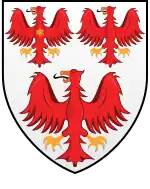 |
The Queen's, confirmed in 1574
Escutcheon: Argent, three eagles displayed gules, beaked and legged or, on the breast of the first, a mullet of six points of the last. | |
 |
St Anne's,
Escutcheon: Gules, on a chevron between in chief two lions heads erased argent, and in base a sword of the second pummelled and hilt or and enfiled with a wreath of laurel, three ravens, all proper. | |
 |
St Antony's, matriculated in 1952
Escutcheon: Or on a chevron between three tau crosses gules as many pierced mullets of the field. | |
 |
St Catherine's
Escutcheon: Sable a saltire ermine between four catherine wheels or. | |
 |
St Cross
Escutcheon: Argent a Cross Potent Purpure a Quarter counterchanged. |
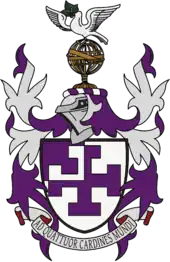 |
 |
St Edmund
Escutcheon: Or, a cross patonce Gules cantoned by four Cornish choughs Proper. | |
 |
St Hilda's
Escutcheon: Azure, on a fess or three estoiles Gules in chief two unicorns' heads couped, in base a coiled serpent Argent. | |
 |
St Hugh's
Escutcheon: Azure, a saltire Ermine, between four fleurs-de-lys Or. | |
 |
St John's
Escutcheon: Gules, on a bordure Sable, eight estoiles Or, on a canton Ermine, a lion rampant of the second, in chief an annulet of the third. | |
 |
St Peter's
Escutcheon: Per pale Vert and Argent, to the dexter two keys in saltire Or surmounted by a triple towered castle Argent masoned Sable and on the sinister a cross Gules surmounted by a mitre Or between four martlets Sable, the whole within a bordure Or. | |
 |
Somerville
Escutcheon: Argent, three mullets in chevron reversed Gules, between six crosses crosslet fitched Sable. |
 |
 |
Trinity
Escutcheon: Per pale or and azure, on a chevron between three griffins' heads erased four fleurs-de-lys, all counter-changed. | |
 |
University, confirmed in 1574
Escutcheon: Azure, a cross patonce between four [sometimes five] martlets or. | |
 |
Wadham, assumed
Escutcheon: Gules, a chevron between 3 roses argent barbed vert (Wadham); impaling Gules, a bend or between 2 escallops argent (Petre). | |
 |
Wolfson
Escutcheon: Per pale Gules and Or on a chevron between three roses two pears all counterchanged the roses barbed and seeded proper. | |
 |
Worcester, assumed from Sir Thomas Cookes
Escutcheon: Or two chevronels Gules between six martlets Sable. |
Roehampton
| Arms | College | Full Achievement |
|---|---|---|
 |
Southlands College, granted 12 February 1968
Escutcheon: Azure, on a chevron cotised between in chief two fleurs-de-lys and in base a lamp Or inflamed proper, three escallops gules. |
 |
| Digby Stuart College, assumed at an unknown date.
Escutcheon: |
West London
| Arms | College | Full Achievement |
|---|---|---|
 |
London College of Music, granted 23 December 1944
Escutcheon: Azure on a pale Argent between two harps Or stringed of the second a sword Gules. |
 |
Arms of constituent halls
Oxford
These are Permanent Private Halls.
| Arms | Hall | Full Achievement |
|---|---|---|
 |
Campion Hall
Escutcheon: Argent on a cross sable a plate charged with a wolf's head erased of the second between in pale two billets of the field that in chief charged with a cinquefoil and that in base with a saltire gules and in fesse as many plates each charged with a campion flower leaved and slipped proper on a chief also of the second two branches of palm in saltire enfiled with a celestial crown or. |
|
 |
Regent's Park College granted 3 March 1958
Escutcheon: Argent, on a cross gules an open Bible proper irradiated Or, the pages inscribed with the words 'Dominus Jesus' in letters sable; on a chief wavy azure a fish gold |
|
 |
St Stephen's House
Escutcheon: Per chevron Gules and Sable in chief two Cross crosslets and in base a Celestial Crown Or. |
|
 |
Wycliffe Hall
Escutcheon: Gules, an open book proper the pages inscribed with the Latin words "Via Veritas Vita" in letters sable on a chief azure three crosses crosslet argent and in base an estoile or. |
Manchester
| Arms | Hall | Full Achievement |
|---|---|---|
.svg.png.webp) |
Hulme Hall
Escutcheon: Barry of eight, Or and Azure, on a canton Argent, a chaplet Gules proper. |
 |
| St. Anselm Hall
Escutcheon: |
 |
Former universities
| Arms | University | Full Achievement |
|---|---|---|
 |
Manchester (Victoria), granted 14 October 1871 as Owen's College, Manchester[161]
Escutcheon: Argent, a serpent nowed vert on a chief nebulée azure, a sun issuant or. |
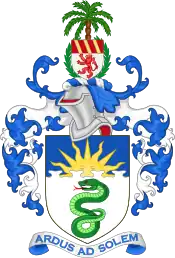 |
 |
Queen's University of Ireland, granted 15 September 1851
Escutcheon: Argent a saltire Gules charged with a royal crown of England between an open ancient book in chief and the Irish harp in base all Proper. | |
 |
Royal University of Ireland, granted 11 October 1881
Escutcheon: Per saltire Ermine and Ermines an open book Proper clasped and surmounted by the royal crown Or between four escutcheons two in pale and two in fess the escutcheons in pale representing respectively the provinces of Leinster and Munster viz. Leinster Vert an Irish harp Or stringed Argent and Munster Azure three antique crowns Or the escutcheons in fess representing respectively the provinces of Ulster and Connaught viz Ulster Or a cross Gules on an escutcheon Argent a dexter hand couped also Gules and Connaught per pale Argent and Azure on the dexter a dimidated eagle displayed Sable and on the sinister conjoined therewith at the shoulder a sinister arm embowed Proper sleeved of the first holding a sword erect also Proper. | |
.svg.png.webp) |
Victoria[13]
Escutcheon: Party per pale Argent and Gules a rose counterchanged between in chief a terrestrial globe semée of bees volant and a golden fleece and in base a cormorant holding in the beak a branch of seaweed called laver all Proper. | |
.svg.png.webp) |
University of Manchester Institute of Science and Technology, granted 1956 as the Manchester College of Technology.
|
 |
Universities formerly within the United Kingdom
| Arms | University |
|---|---|
 |
Dublin, granted 28 March 1862 by Sir John Bernard Burke, Ulster King of Arms[162]
Escutcheon: Quarterly Azure and Ermine in the first quarter a book open Proper bound Gules clasped Or and in the fourth quarter a castle of two towers Argent flammant Proper over all in the centre point the harp of Ireland ensigned with the royal crown.[163] The university was established in 1592 by a charter issued by Queen Elizabeth I. It is the degree awarding body for Trinity College Dublin. The harp is a symbol of Ireland. The crown represents Queen Elizabeth I and the book/bible learning and the Christian faith. The castle is taken from the arms of the city of Dublin.[164] |
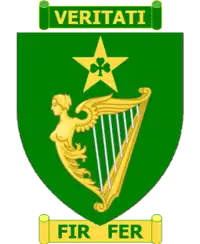 |
Ireland (National), granted 7 May 1912 by Nevile Wilkinson, Ulster King of Arms.[165] Escutcheon: Vert a harp Or with seven strings Argent in chief a five-pointed star of the second charged with a trefoil of the field. The constituent colleges (Dublin, Galway and Cork at foundation) of the federal National University of Ireland are since Irish independence located within the republic of Ireland. The harp is a symbol of Ireland. The star represents enlightenment and it is adorned by a shamrock another Irish symbol. The background colour is green linking to Ireland and the shamrock.[166] |
Former constituent colleges
| Arms | College | |
|---|---|---|
 |
Armstrong College, Durham[167]
Escutcheon: Argent, a cross pattée, quadrat in the centre gules, on a chief of the last three towers of the first, all within a bordure compony of the second and or, on a canton the arms of Baron Armstrong. | |
 |
The College of the Venerable Bede, Durham[168]
Escutcheon: Argent, an ancient Northumbrian cross gules a chief azure thereon between two lions rampant or a pale gold charged with a cross patonce also azure. |
 |
 |
Bedford College, London, granted 13 August 1913[148]
Escutcheon: Argent, between two flaunches paly bendy Or and sable a cross patee throughout gules voided of the field surmounted by an open book of the second; on a chief of the third, an antique lamp gold enflamed proper. | |
 |
Bishop Cosin's Hall, Durham[13]
Escutcheon: Azure, a fret or. | |
 |
Bull College, Cambridge
Escutcheon: | |
 |
Cardinal College, Oxford[170]
Escutcheon: Azure, on a cross engrailed argent a lion passant gules between four leopards' faces of the field, in the first quarter a griffon passant supporting a column or, in the second quarter an open book argent leathered gules, garnished or, on a chief of the last a Cardinal's hat of the third, between a torteau charged with two crosses in saltire of the fourth and a key of the second encircled by a crown of the fourth, and a hurt charged with a lion rampant argent, collared of the fourth, and a saltire of the last. | |
 |
Chelsea College, London
(Merged into King's College London 1985.) | |
 |
Heythrop College, University of London
Motto: Nil Sine Fide (Nothing Without Faith) | |
 |
Neville's Cross College, Durham[168]
Escutcheon: Argent a cross patee quadrate gules on a canton of the second a saltire of the field. | |
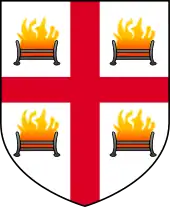 |
Queen Elizabeth College, London[151]
Escutcheon: Argent, a cross gules between four blazing hearths proper. | |
 |
Queen Mary College, London[148]
Escutcheon: Azure upon three several clouds (the sun-beams issuing ) three ancient imperial, crowns tripled all proper on a chief gules an open book also proper embellished and clasped or and inscribed SOLI DEO HONOR ET GLORIA in letters sable between two mullets also or. | |
 |
Royal Holloway College, London, granted 1 May 1944[171]
Escutcheon: Ermine, on a cross gules another argent, over all in the fesse point an open book proper; on a chief of the second three crescents Or. | |
.svg.png.webp) |
St Hild's College, Durham
Escutcheon: (in 1964; illustrated left)[168] Argent a cross patee quadrate gules on a canton vert an ammonite or. |
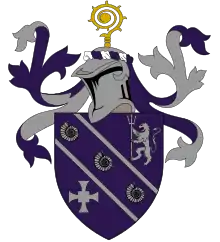 |
 |
University of Durham College of Medicine[13]
Escutcheon: Argent, St Cuthbert's cross gules, a chief tierced in pale; (a) the arms of Bishop Hatfield; (b) Or, the rod of Eusclapius in pale proper; (c) Gules, a castle argent. | |
 |
Westfield College, London[173]
Escutcheon: Sable, a cross quadrate Or; on a chief of the last an open book proper bound gules between two mascles that on the dexter enclosing a sinister hand couped appaumee, that on the sinister a lion's paw erased, all of the first. |
See also
References
- Aston, Trevor (1984). The History of the University of Oxford: The early Oxford schools. Oxford University Press. p. 94. ISBN 9780199510115.
- "Oxford University and its Colleges". The Heraldry Society. 4 March 2018. Retrieved 19 June 2020.
- "Cambridge University and its Colleges". The Heraldry Society. 4 March 2018. Retrieved 19 June 2020.
- "The colleges and halls: King's". British History Online. Retrieved 19 June 2020.
- "Services". College of Arms.
- "Protected by their shields? Why are UK universities increasingly adopting coats of arms as their logos?". echer.org. Retrieved 19 June 2020.
- "The coat of arms". cam.ac.uk. University of Cambridge. 22 January 2014. Retrieved 19 June 2020.
- "Logo". york.ac.uk. University of York. Retrieved 19 June 2020.
- "Our Coat of Arms". fitz.cam.ac.uk. Fitzwilliam College MCR. Retrieved 19 June 2020.
- Patterson, Bruce (1998). "Trends in university heraldry: the British empire and beyond". In Claire Boudreau; Daniel Cogné; Auguste Vachon (eds.). Actes Du 22e Congrès International Des Sciences Généalogique Et Héraldique À Ottawa 18-23 Août 1996. University of Ottawa Press. pp. 419–428. ISBN 9780776604725.
- "University of Warwick - Armorial Bearings of the University". Retrieved 2 July 2019.
- Fox-Davies, Arthur (1915). The Book of Public Arms. pp. 800–814.
- Treatise on Ecclesiastical Heraldry. W. & A.K. Johnston. 1894. pp. 426–456. ISBN 9785878640695.
- "The College crest". imperial.ac.uk. Imperial College London. Retrieved 28 March 2020.
- "University of Dublin". heraldry-wiki.com. Heraldry of the World. 23 September 2018. Retrieved 19 June 2020.
- Buck, G, ‘A Discourse or Treatise on the Third University of England,’ in Stow, J. Annales, or, a general chronicle of England. (1615). London. Richardi Meighen.
- "University of Aberdeen – Coat of arms (crest) of University of Aberdeen". www.ngw.nl. Retrieved 8 August 2017.
- "University of Aberdeen – Armorial Tablet". The Heraldry Society of Scotland. Retrieved 18 August 2007.
- "The coat of arms". University of Cambridge. 22 January 2014. Retrieved 3 October 2020.
- "University Coat of Arms". collections.ed.ac.uk. Retrieved 17 August 2022.
- Guillim, John (1610). The Display of Heraldrie. p. 210.
- "University of St Andrews". www.st-andrews.ac.uk.
- Joseph Thomas Fowler (1904). "Grant of Arms to the University". Durham University: earlier foundations and present colleges. F. E. Robinson. pp. 256–257.
- John Woodward (1894). A Treatise On Ecclesiastical Heraldry. W. & A.K. Johnston. ISBN 9785878640695.
- "Calendar of the Charles Thorp Correspondence". Durham University. THO/593. Retrieved 20 August 2022.
The university is the legitimate successor of Durham College, the property of which remained since the reformation in the hands of the Chapter and which successive Governments from Henry VIII downwards have proposed to apply to academic education at Durham
- Fox-Davies, Arthur Charles (1915). "The Book of Public Arms". archive.org.
- "University of Wales". www.wales.ac.uk.
- "University of Bristol". www.bristol.ac.uk.
- "University of Exeter". heraldry-wiki.com. Heraldry of the World. Retrieved 13 May 2020.
- "University of Hull". heraldry-wiki.com. Heraldry of the World. 19 April 2019. Retrieved 2 July 2019.
- "University of Leicester". heraldry-wiki.com. Heraldry of the World. 18 February 2018. Retrieved 3 July 2019.
- University of Leicester. "Our Motto and Coat of Arms". ourhistory.le.ac.uk.
- "University of Liverpool". heraldry-wiki.com. Heraldry of the World. 19 March 2019. Retrieved 19 June 2020.
- "Elsewhere in the Archives". Newsletter. College of Arms (45). January 2016.
- "University of Newcastle upon Tyne". heraldry-wiki.com. Heraldry of the World. Retrieved 21 June 2020.
- "Coat of Arms". www.nottingham.ac.uk. University of Nottingham. Retrieved 25 September 2023.
- "University of Nottingham". heraldry-wiki.com. Heraldry of the World. 19 March 2019. Retrieved 3 July 2019.
- "Grants and Confirmations of Arms Vol. K". National Library of Ireland. p. 177. Retrieved 25 June 2022.
- Fox-Davies, Arthur (1915). The Book of Public Arms. pp. 648–649.
- University of Reading. "90th anniversary". www.reading.ac.uk.
- Fox-Davies, Arthur (1915). The Book of Public Arms. p. 648.
- "The University of Sheffield". www.sheffield.ac.uk. 20 March 2023.
- "University Calender 2007/8". www.calendar.soton.ac.uk. University of Southampton. Retrieved 30 September 2023.
- "University of Southampton". www.southampton.ac.uk.
- Aston University. "The Arms of Aston University". www.aston.ac.uk.
- "The story of the University".
- "University of Bath, Coat of arms". 12 September 2015.
- "100 Objects from Special Collections at the University of Bradford". 100objectsbradford.wordpress.com. 27 July 2011.
- "University of Essex". www.essex.ac.uk.
- "Heriot Watt College". heraldry-wiki.com. Heraldry of the World. Retrieved 23 March 2021.
- "Two centuries of learning Your Guide to Heriot-Watt University's Heritage" (PDF). www.hw.ac.uk. Heriot-Watt University. Retrieved 12 September 2023.
- "Keele University". heraldry-wiki.com. Heraldry of the World. 23 June 2017. Retrieved 4 July 2019.
- Graham Martin, From Vision to Reality: the Making of the University of Kent at Canterbury (University of Kent at Canterbury, 1990) pages 33–36 ISBN 978-0-904938-03-6
- "University of Loughborough". heraldry-wiki.com. Heraldry of the World. Retrieved 2 July 2019.
- "December 2011 Newsletter (No. 31)". College of Arms. December 2011. Retrieved 24 May 2023.
OPEN UNIVERSITY. Arms, Crest and Supporters in substitution for those previously granted to the Open University in 1971. Garter, Clarenceux and Norroy and Ulster Kings of Arms. 15/6/2011. College reference: Grants 175/341
- "Recent Grants of Arms". Newsletter. College of Arms (50). April 2017.
- "Coat of Arms". www.stir.ac.uk. University of Stirling. Retrieved 6 September 2023.
- "Significant Dates - University of Strathclyde". studylib.net. Retrieved 19 September 2023.
- "Remembering Battersea" (PDF). www.surrey.ac.uk. University of Surrey. Retrieved 6 September 2023.
- "Imagery of the Key". www.brown.edu. Brown University.
- "University of Sussex". heraldry-wiki.com. Heraldry of the World. 23 January 2019. Retrieved 9 March 2020.
- "Did you know the University of Sussex has a Coat of Arms?". www.sussex.ac.uk. University of Sussex. Retrieved 7 September 2023.
- "University of York". heraldry-wiki.com. Heraldry of the World. Retrieved 2 July 2019.
- "Arms of the Irish Universities". www.andrewcusack.com. Retrieved 20 September 2023.
- "Talks series to celebrate 25 years of Abertay University". 14 September 2021.
- "About Us". University of Central Lancaster.
- "What should the University of Central Lancashire's new logo be?". www.blogpreston.co.uk.
- "Coventry University Logo". www.coventrysociety.org.uk. 9 November 2022.
- "The Arms of the University". Cranfield University. Retrieved 1 July 2017.
- "DMU's coat of arms, logo and mace". dmuheritage.our.dmu.ac.uk. 19 February 2016.
- "Recent Grants of Arms". Newsletter. College of Arms (37). December 2014.
- "NEVER NOT PUSHING FORWARD - Our Timeline". uel.ac.uk. University of East London. Retrieved 13 September 2023.
- "Quasquicentennial 1990". blogs.gre.ac.uk. University of Greenwich. Retrieved 14 September 2023.
- "Recent Grants of Arms". Newsletter. College of Arms (29). June 2011.
- University of Lincoln. "Corporate Identity". www.lincoln.ac.uk.
- "Manchester Metropolitan University". www.mmu.ac.uk. Retrieved 3 September 2022.
- "Northumbria University". www.northumbria.ac.uk.
- "No. 62091". The London Gazette. 25 October 2017. p. 19746.
- "Newsletter 55". www.college-of-arms.gov.uk. College of Arms. Retrieved 12 September 2023.
- Allan, Cliff. "SHU-Brand-Guideline" (PDF). blogs.shu.ac.uk. Sheffield Hallam University. Retrieved 13 September 2023.
- "Our Heritage - Staffordshire University". Staffordshire University.
- University of Sunderland. "Our History". london.sunderland.ac.uk.
- "University of the West of England, Bristol". www.uwe.ac.uk.
- "Our Crest". University of Wolverhampton.
- "Our Crest". www.wlv.ac.uk. University of Wolverhampton. Retrieved 18 September 2023.
- "History of Aberystwyth University". www.aber.ac.uk.
- "Welsh Icons Website". welshicons.org.
- "Elsewhere in the Archives". Newsletter. College of Arms (46). April 2016.
- Hartemink, Ralf. "Bishop Grosseteste University". www.heraldry-wiki.com. Retrieved 28 September 2023.
- "Governance".
- "Buckinghamshire New University Brand Guide 2021". issuu.com. Buckinghamshire New University. Retrieved 25 September 2023.
- "The return of the chough". www.canterbury.ac.uk. Canterbury Christ Church University. Retrieved 25 September 2023.
- Cheshire Heraldry. "University of Chester". cheshire-heraldry.org.uk/.
- September 2007 Newsletter (No. 14). "College of Arms Newsletter". www.college-of-arms.gov.uk.
- Edge Hill University. "Colours, crest and mace". www.edgehill.ac.uk.
- "Newsletter 55". www.college-of-arms.gov.uk. College of Arms. Retrieved 12 September 2023.
- "January 2020 Newsletter (no. 61)". www.college-of-arms.gov.uk. College of Arms. Retrieved 25 October 2023.
- "University of the Highlands and Islands". www.uhi.ac.uk.
- "University of Highlands and Islands unveils coat of arms". www.historyscotland.com. 13 June 2012.
- Arthur Charles Fox-Davies (1915). The Book of Public Arms. T. C. & E. C. Jack. Retrieved 28 March 2020.
- "The College crest". www.imperial.ac.uk. Imperial College. Retrieved 12 September 2023.
- "The Arms, Crest, Supporters and Badge of Liverpool Hope University". College of Arms. 29 April 2010.
- "University of Northampton" (PDF). www.northampton.ac.uk.
- "Queen Margaret University Edinburgh". www.qmu.ac.uk.
- "The University Shield and Crest: past and present". raulibrary.wordpress.com. Royal Agricultural University.
- "Our Coat of Arms". Solent University.
- "King Alfred inspires University's Grant of Arms". VENTA for alumni and friends of the University of WInchester (19): 7. Winter 2008. Retrieved 21 September 2023.
- "No. 58062". The London Gazette. 4 August 2006. p. 10686.
- "October 2009 Newsletter (No. 22)". College of Arms.
- "Christ's College (Cambridge University)". heraldry-wiki.com. Heraldry of the World. Retrieved 10 March 2020.
- Members of the Cambridge University Heraldic and Genealogical Society (1985). Humphery-Smith, C. R.; Peek, H. E.; Wright, G. H.; Scott-Giles, C. W. (eds.). The Cambridge Armorial. London: Orbis. pp. 112–115. ISBN 0856138711.
- "Clare College (Cambridge University)". heraldry-wiki.com. Heraldry of the World. 18 January 2019. Retrieved 23 June 2020.
- Members of the Cambridge University Heraldic and Genealogical Society 1985, p. 122.
- "The Clare Hall Crest". Clare Hall Cambridge. Retrieved 23 June 2020.
- Arthur Charles Fox-Davies (1915). The Book of Public Arms. p. 212.
- "Darwin College (Cambridge University)". Heraldry of the World. 24 February 2020. Retrieved 23 June 2020.
- "Downing College (Cambridge University)". Heraldry of the World. 18 January 2019. Retrieved 23 June 2020.
- "Emmanuel College (Cambridge University)". Heraldry of the World. 18 January 2019. Retrieved 23 June 2020.
- Members of the Cambridge University Heraldic and Genealogical Society 1985, pp. 108–111.
- "Fitzwilliam College (Cambridge University)". Heraldry of the World. 18 January 2019. Retrieved 23 June 2020.
- "Girton College (Cambridge University)". Heraldry of the World. 18 February 2018. Retrieved 23 June 2020.
- "Gonville & Caius College (Cambridge University)". Heraldry of the World. Retrieved 23 June 2020.
- "Homerton College (Cambridge University)". Heraldry of the World. 18 February 2018. Retrieved 24 June 2020.
- Members of the Cambridge University Heraldic and Genealogical Society 1985, p. 123.
- "Jesus College (Cambridge University)". Heraldry of the World. Retrieved 24 June 2020.
- "King's College (Cambridge University)". Heraldry of the World. 18 January 2019. Retrieved 24 June 2020.
- "Lucy Cavendish College (Cambridge University)". Heraldry of the World. 16 February 2020. Retrieved 24 June 2020.
- "Magdalene College (Cambridge University)". Heraldry of the World. 18 January 2019. Retrieved 24 June 2020.
- Members of the Cambridge University Heraldic and Genealogical Society 1985, p. 116.
- "Newnham College (Cambridge University)". Heraldry of the World. 18 February 2018. Retrieved 24 June 2020.
- "Pembroke College (Cambridge University)". Heraldry of the World. 18 January 2019. Retrieved 24 June 2020.
- "Peterhouse College (Cambridge University)". Heraldry of the World. 18 January 2019. Retrieved 24 June 2020.
- "Queens' College (Cambridge University)". Heraldry of the World. Retrieved 24 June 2020.
- Members of the Cambridge University Heraldic and Genealogical Society 1985, p. 130.
- "St Catharine's College (Cambridge University)". Heraldry of the World. 18 January 2019. Retrieved 24 June 2020.
- Members of the Cambridge University Heraldic and Genealogical Society 1985, pp. 72–75.
- "Selwyn College (Cambridge University)". Heraldry of the World. 18 January 2019. Retrieved 25 June 2020.
- "Sidney Sussex College (Cambridge University)". Heraldry of the World. 18 January 2019. Retrieved 25 June 2020.
- "Trinity College (Cambridge University)". Heraldry of the World. 18 January 2019. Retrieved 25 June 2020.
- "Trinity Hall College (Cambridge University)". Heraldry of the World. 18 January 2019. Retrieved 25 June 2020.
- Members of the Cambridge University Heraldic and Genealogical Society 1985, pp. 120–121.
- "Arms and Mottos". Durham University Calendar 2019–2020. Vol. I. Retrieved 20 June 2020.
- "Hatfield College (Durham University)". heraldry-wiki.com. Heraldry of the World. Retrieved 19 June 2020.
- "Crest & Motto". Hatfield College. Retrieved 22 June 2020.
- "St Chad's College (Durham University)". heraldry-wiki.com. Heraldry of the World. Retrieved 19 June 2020.
- "County College (Lancaster University)". heraldry-wiki.com. Heraldry of the World. 2 August 2020. Retrieved 20 February 2023.
- "Fylde Rural District Council". Civic Heraldry of England, Wales and Northern Ireland. Retrieved 6 April 2023.
- JS Cockburn; HPF King; KGT McDonnell, eds. (1969). The University of London: The Constituent Colleges. pp. 345–359.
{{cite book}}:|work=ignored (help) - "Birkbeck College, University of London". heraldry-wiki.com. Heraldry of the World. Retrieved 2 July 2019.
- "The London Gazette - No. 53987" (PDF). Retrieved 2 July 2019.
- Neville Marsh (2007). "The KCHSS/QEC Coat of Arms – A short history" (PDF). Envoy. KCHSS and QEC Alumni Association. pp. 14–16. Retrieved 24 June 2020.
- ""Cheerful nonsense with brains behind it" – devising the LSE coat of arms". LSE History. LSE. 20 June 2017. Retrieved 25 June 2020.
- "Chronology 1990-1999". School of Physics and Astronomy. Queen Mary University of London. Retrieved 2 January 2021.
- "The Caroline Skeel Archives Reading Room". Queen Mary University of London Library. Retrieved 1 January 2021.
- Kellogg College The First 25 Years. 2015.
- Marlin, J.T. "HERALDRY: St Cross College, Oxford". Archived from the original on 30 June 2016. Retrieved 29 June 2019.
- "Southlands College of Education". Heraldry of the World. Retrieved 21 October 2021.
- "London College of Music". Heraldry of the World. Retrieved 18 February 2021.
- "January 2021 Newsletter (No. 63)". College of Arms. Retrieved 1 February 2021.
- Thompson, K. P. "THE HISTORY OF WILLIAM HULME'S GRAMMAR SCHOOL MANCHESTER" (PDF). whgs-academy.org. Retrieved 22 April 2023.
- Fox-Davies, Arthur (1915). The Book of Public Arms. p. 584.
- "Grants and Confirmations of Arms". catalogue.nli.ie. National Library of Ireland. p. 402. Retrieved 22 July 2022.
- Fox-Davies, Arthur (16 October 2018). The Book of Public Arms. Reprint - Forgotten Books. p. 802. ISBN 978-1528309837. Retrieved 24 September 2023.
- Scattergood, John. "ARMS, TRINITY COLLEGE AND THE UNIVERSITY OF DUBLIN" (PDF). brianmlucey.wordpress.com/. Retrieved 23 September 2023.
- "Grants and Confirmations of Arms Vol. K". National University of Ireland. p. 401. Retrieved 26 June 2022.
- "Arms of the Irish Universities". www.andrewcusack.com. Retrieved 20 September 2023.
- Fox-Davies, Arthur (1915). The Book of Public Arms. pp. 34–35.
- University of Durham Calendar 1964-1965. Durham University. 1964. pp. 150–151.
- Bull College (?) Cambridge, 1945-1946, The Escutcheon, Volume 15, Number 2 – Lent Term, 2010
- Fox-Davies, Arthur (1915). The Book of Public Arms. p. 154.
- "Royal Holloway College, University of London". Heraldry of the World. Retrieved 24 June 2020.
- University of Durham Calendar 1969-1970. Durham University. 1969. pp. 182–183.
- "Westfield College (London University)". Heraldry of the World. Retrieved 24 June 2020.
